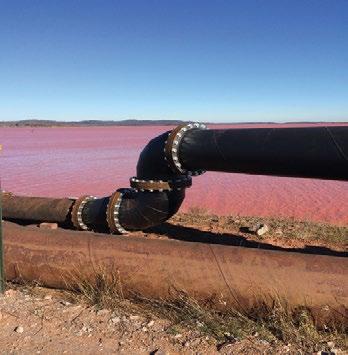Australia: Brightening Up as the Latest REE Producer
just surpassed china to become the fourth greatest producer of rees in the world, and
a slew of new ree projects and discoveries, it may be ready to challenge china's dominance as the world's top
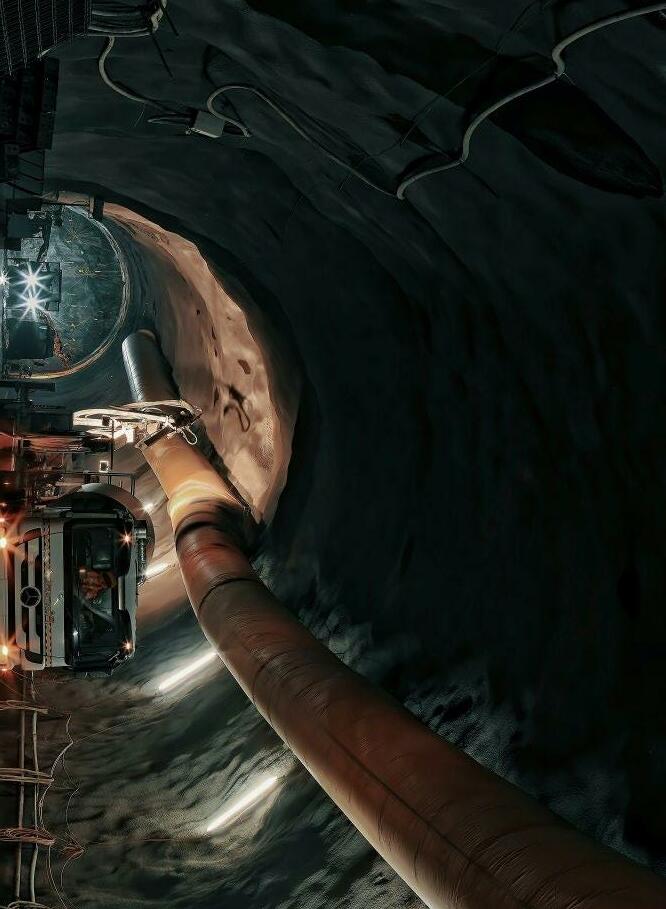
of rees.

2022 OCTOBER IN REVIEW 111/10 32 interview with trina igelsrud pfeiffer, interim director, center for carbon capture and conversion, at the university of wyoming grängesberg iron ore, dalarna county, sweden, resuming audit: intelligent unmanned mining 28 36 08 australia
with
producer
2 | SKILLINGS MINING REVIEW October 2022 BIG RESULTS SMALL TEAM Optiro is a resource consulting and advisory group. Our 5 core services are Geology, Mining Engineering, Corporate, Training and Software. In eleven years, our team has travelled the world providing expertise to improve, value, estimate and audit the world’s minerals. Pound for pound we think you’ll find no-one delivers greater value –and BIG results. +$15 BILLION DEALS/ VALUATIONS >780 MILLION oz Au RESOURCE AUDITS >64 MILLION oz Au RESOURCE ESTIMATES >3,000 CLIENTS +2,000 PEOPLE TRAINED 24 COMMODITIES 53 COUNTRIES >4,300 MILLION lb NICKEL >5,100 MILLION lb COPPER+5 IRON ORE BILLION TONNES www.optiro.com contact@optiro.com +61 8 9215 0000
THE LEAD
08 Australia: Brightening Up as the Latest Rare Earth Elements Producer
MINING EQUIPMENT
22 Novel Self-Propelled Bale Chaser: Contractor Work
MINING FINANCE
14 Insider Buys Anglo American plc Shares Worth £173.28

PROFILES IN MINING
32 Interview with Trina Igelsrud Pfeiffer, Interim Director, Center for Carbon Capture and Conver sion, at the University of Wyoming
SPECIAL FOCUS
16 Mining Technology Inculca tion: Australia a Trendsetter!
29 Grängesberg Iron Ore, Dalarna County, Sweden Resuming
36 Audit: Intelligent Unmanned Mining
SURFACE MINING
05 Agnico Eagle’s Fosterville Gold Mine: Big Preparations
06 Iron-Ore Processing: New Gen Compact Pelletizing
06 Mantos Blancos and Manot verde mines in Chile
06 Metso Outotec Expands: Pennsylvania
15 Shaft sinking innovations, safer workplace by 2040
19 Slam Exploration Mobilizing to Drill Gold Veins at Menneval
31 Vale Unveils the Next Sus tainable Sand Operation
STATISTICS
26 Great Lakes Iron Ore Trade Down in August
46 August 2022 crude steel production
47 Crude steel production December 2020
UNDERGROUND MINING
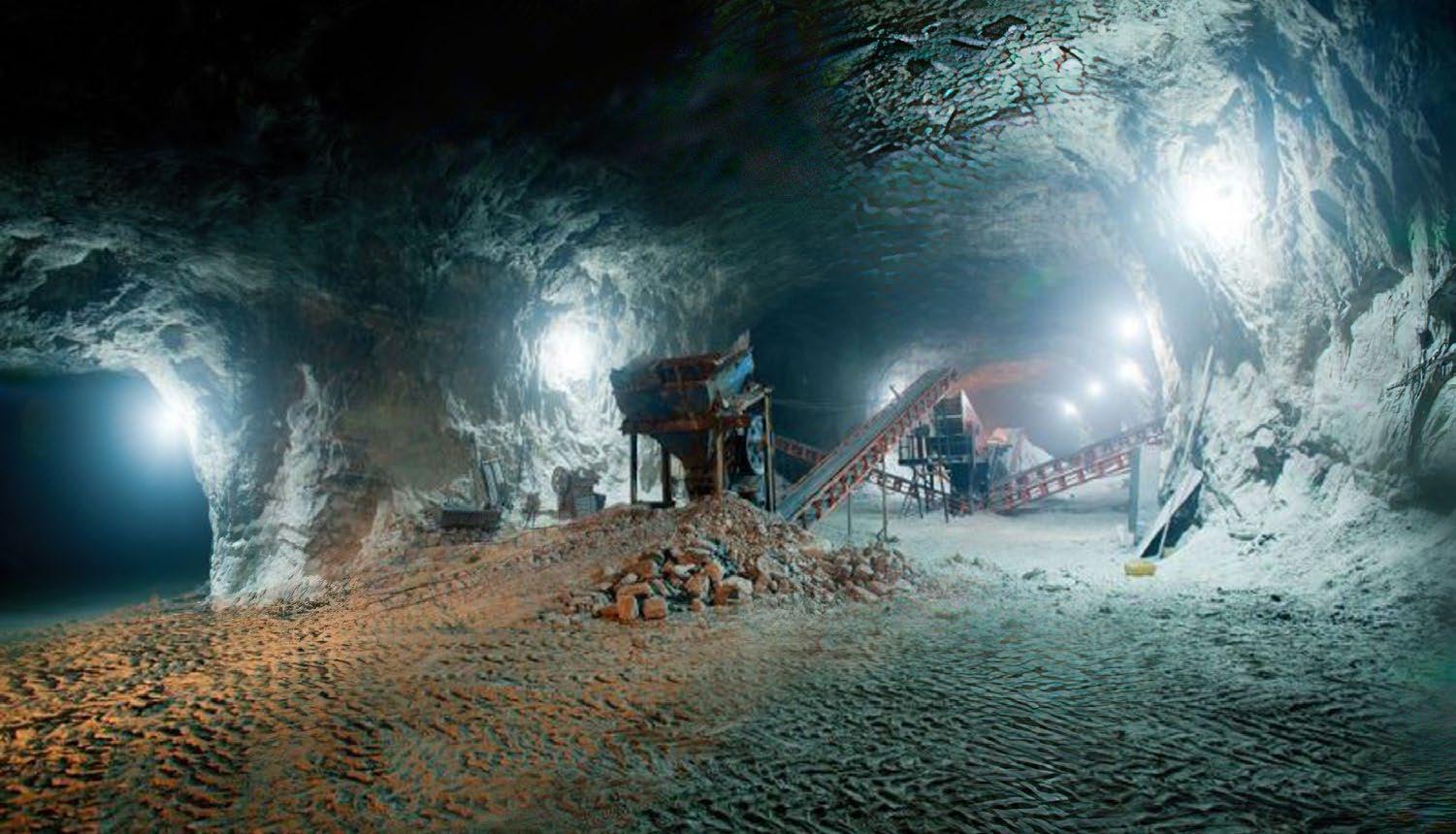
14 India: Sandvik Mining Automa tion Learning Center Opened
20 Viscount Mining TITAN MT Survey Confirms Conductive Anom aly at Silver Cliff, Colorado
39 Iron & Steel: The Route Starts!
40 Awards Ceremony Recogni tion: Longwall Automation from Anglo American’s Milestones
44 Phase III RC Drilling Results Confirm Southern Extension of Christmas Gift Prospect Bur racoppin Gold Project, WA
www.skillings.net | 3
UNITED STATES
$72 Monthly in US Funds
$109 Monthly in US Funds 1st Class Mail
Skillings Mining Review of CFX Network
comprehensive information on global mining,
industry issues via Skillings Mining
Americas, Global Skillings
and
OUTSIDE OF UNITED STATES
$250 US Monthly for 7 - 21 day delivery $335 US Monthly for Air Mail Service
All
SKILLINGS MINING REVIEW NEWS ROOM


Digital Monthly Magazine
SMR Americas Monday Global Skillings Wednesday Skillings Equipment Gear Friday
CUSTOMER SERVICE/ SUBSCRIPTION QUESTIONS:
For renewals, address changes, e-mail preferences and subscription account status contact Circulation and Subscriptions: subscriptions@Skillings.net
Editorial matter may be reproduced only by stating the name of this publication, date of the issue in which material appears, and the byline, if the article carries one.
www.skillings.net
SKILLINGS MINING REVIEW
(ISSN 0037-6329) is published monthly, 12 issues per year by CFX Network, 350 W. Venice Ave. #1184 Venice, Florida 34284
Phone: (888) 444 7854 x 4. Printed in the USA.
Payments & Billing: 350 W. Venice Ave. #1184, Venice, FL 34284.
Periodicals Postage Paid at: Venice, Florida and additional mail offices.
Postmaster: Send address changes to: Skillings mining review, 350 W. Venice Ave. #1184 Venice, Florida 34284.
Phone: (888) 444 7854 x 4. Fax: (888) 261-6014. Email: Advertising@Skillings.net.
SUBSCRIPTIONS
funds are monthly $4.95 USD per month publisher CHARLES PITTS chas.pitts@skillings.net managing editor SAKSHI SINGLA sakshi.singla@skillings.net editor-in-chief JOHN EDWARD john.edward@skillings.net creative director MO SHINE mo.shine@skillings.net contributing editors ROB RAMOS AALIYAH ZOLETA MARIE GABRIELLE media production STANISLAV PAVLISHIN media.team@cfxnetwork.com media administrator SALINI KRISHNAN salini.krishnan@cfxnetwork.com director of sales & marketing CHRISTINE MARIE advertising@skillings.net profiles in mining mining.profiles@skillings.net general contact information info@cfxnetwork.com 2022 OCTOBER VOL.111. NO.10
LLC, publishes
iron ore markets
critical
Review Monthly Magazine and weekly. SMR
and Skilling Equipment Gear newsletters.
4 | SKILLINGS MINING REVIEW October 2022
Agnico Eagle’s Fosterville Gold Mine:

Big Preparations
Agnico EAglE will invEstigAtE thE AdvAntAgEs of bAttEry ElEc tric underground technology after receiving a planned Sandvik LH518B underground loader to be tested at its Fosterville gold mine in Victoria, Australia. This research will take place in the second half of 2022.

The Fosterville operation, 20 kilometers from Bendigo, will receive the new Sandvik loader, making it the second mine in Australia to do so (the first being Gold Fields' St Ives operation in Western Australia).
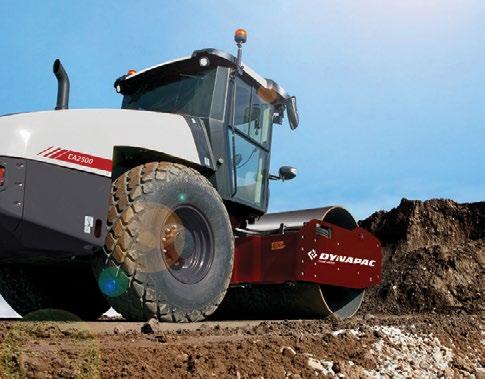
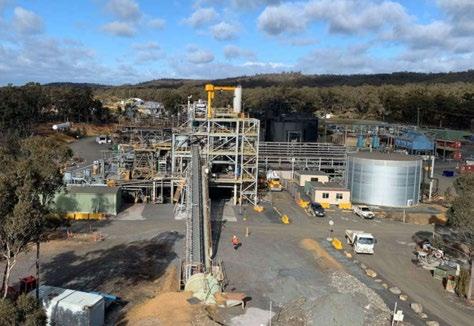
However, Fosterville will be the first mine on Australia's East Coast. The LH518B produces zero subterranean exhaust emissions and releases substantially less heat than its diesel
competitors because of its cutting-edge lithium-iron-phosphate battery technology.
At the IMARC Online conference in November 2020, Rob McLean—at the time Fosterville's Chief Mining Engineer— announced intentions for the operation to test the Sandvik LH518B.
He said that the experiment, which was ini tially scheduled for 2021, was a component of the firm's vision to "have a fully electric mine," with the nearest objectives being the elimination of diesel emissions and a decrease in heat at the facility.
www.skillings.net | 5
Metso Outotec
Expands: Pennsylvania
According to Metso Outotec, all its mineral testing services are now provided out of a single 5,500 m2 facility in York, Pennsylvania. The Test Center's capabilities will be continuously improved to support the global mining sector by addressing the entire minerals value chain.
"Year 2021 has seen a huge increase in testing activity volume. We can conduct a lot more linked and pilot-scale testing if we have more room and activities in one location. The test centre in York focuses on grinding R&D in close collaboration with our headquarters in York, as well as standard and custom grind ing tests in both laboratory and pilot size. We can now do tests for calcining, induration, and drying thanks to the addition of pyro testing capabilities. We are now developing new tools for bench and lab-scale filtra tion and thickening experiments”, says Alan Boylston, director of process engineering at Metso Outotec.
Iron-Ore Processing: New Gen Compact Pelletizing
MEtso outotEc lAunchEd its “coMpAct sizEd pEllEt plAnt” after optimizing its current induration technology.
T he facility is built on the cutting-edge design of the company's larger (4-m wide) product range and is based on
a 3-m wide indurating machine. Similar plant performance and product quality are provided by the new compact plant as is done by the larger-size plants. 189 m2 (1.21.5 million metric tons per year (m.t./yr)), 288 m2 (1.7-2.3 million m.t./yr), and 315 m2 (2.0-2.6 million m.t./yr) are the three standard sizes (capacities) that are available.

Mantos Blancos and Manotverde mines in Chile

At its chilEAn fAcilitiEs in MAntos blAncos And MAntovErdE,
Capstone Copper Corp. claims it has committed to the Copper Mark. The Copper Mark is a system of assurance designed to support ethical production methods and show the industry's dedication to the UN Sustainable Development Goals.
T he 32 responsible production requirements for the Copper Mark, including environmental management, greenhouse gas emissions, human rights, community health, safety and development, and governance, will
be evaluated and independently validated for Mantos Blancos and Mantoverde within a year. "I am delighted to share that our Mantos Blancos and Mantoverde operations have joined the Copper Mark framework, underlining our commitment to consistently pursue best practises based on worldwide standards for responsible mining," said John MacKenzie, CEO of Capstone.
It is our duty to ensure that we deliver copper in the most sustainable way possible because it is crucial to a low-carbon future.
6 | SKILLINGS MINING REVIEW October 2022 SURFACE MINING


ME Elecmetal Comminution Solutions Innovative Solutions - Proven Performance www.me-elecmetal.com ME Elecmetal o ers more than mill liners — we o er innovation, support, custom designs and valuable tools to develop a total comminution solution speci c to your needs. We are on the ground with our customers — setting common goals and providing timely responses based on e ective collaboration. Drawing on over 100 years of experience and advanced technologies, we will help you optimize processes, extend the lifespan of wear parts, reduce operational risks and increase pro tability. Innovative Mill Lining Solutions for SAG, AG, Ball, Tower & Rod Mills • Steel • Rubber • Composite Premium Quality Forged Steel Grinding Media for SAG, Ball & Rod Mills • ME Super SAG®: 4.0” to 6.25” • ME Ultra Grind®: 1.5” to 4.0” • ME Ultra Grind®II: 2.0“ to 4.0” • ME Performa®: 7/8” to 1.5” Wear Components for Primary, Secondary & Tertiary Crushers • Gyratory Crushers • Jaw Crushers • Cone Crushers
Earth Elements
You would have probably heard about China's supremacy in producing vital rare earth elements (REEs). Australia just surpassed China to become the fourth greatest producer of REEs in the world, and with a slew of new REE projects and discoveries, it may be ready to challenge China's dominance as the world's top producer of REEs.


Producer 8 | SKILLINGS MINING REVIEW September 2022 THE LEAD image © Jacob Kepler/Bloomberg
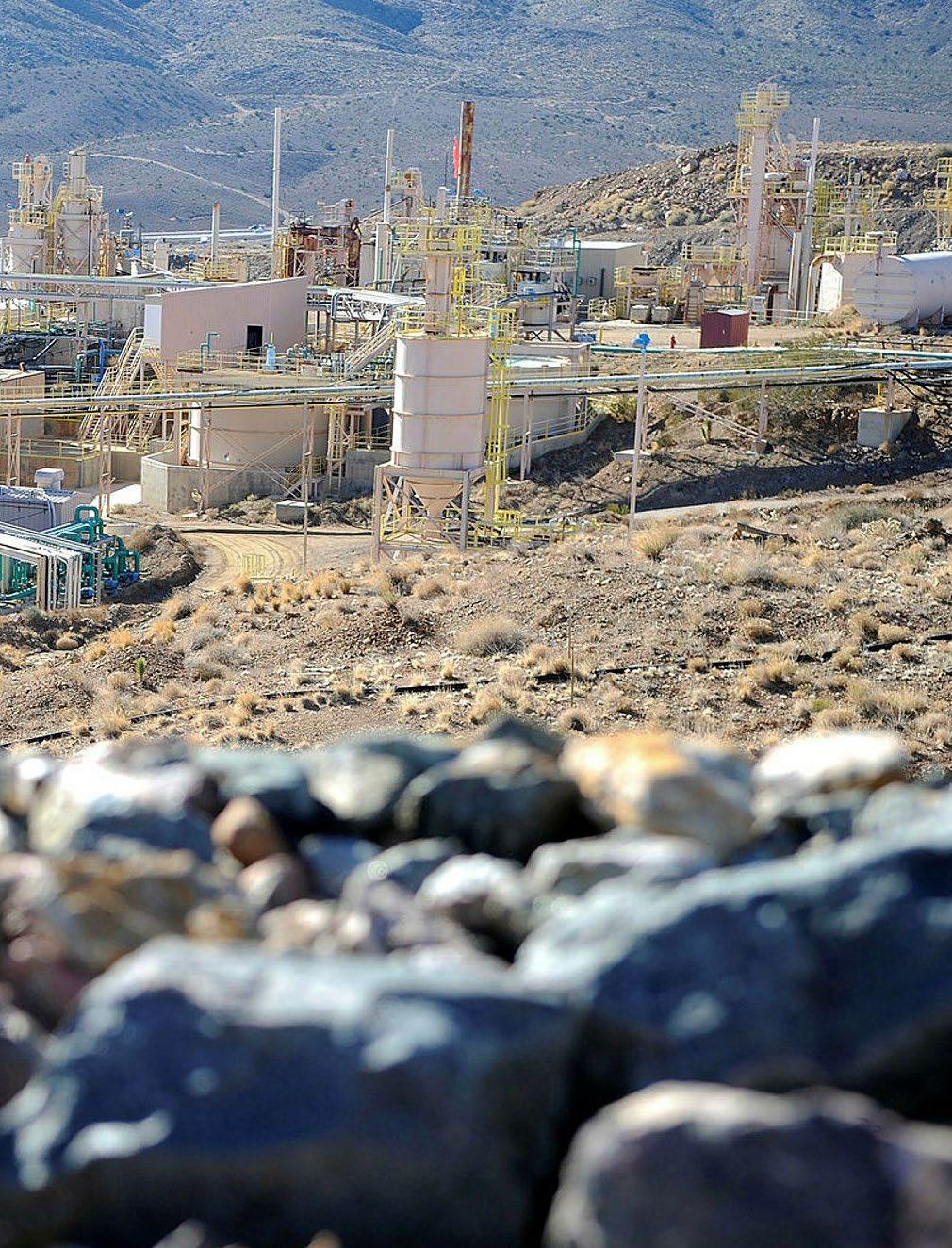
www.skillings.net | 9
Unique Earths
The chemically related elements Yttrium (Y) and Scandium (Sc), which are located at the bottom of the periodic table, are frequently grouped in the group of elements known as rare earths. The most frequent element, cerium, is nearly as common in the earth's crust as copper, whilst the rarest element, lutetium, is more than 80 times less abundant.
Despite their names, these elements are not all equally uncommon. Compared to heavy rare earths, light rare earths (LREE) are much more prevalent and less expensive (HREE).
Many high-tech products, like the displays on smartphones, the magnets in wind turbines and electric vehicles, and missile guidance systems, depend on REEs. Due to the rarity of the deposits and the expensive, time-con suming, and frequently environmentally
damaging ore processing, it has been difficult to develop a reliable supply of these strate gically and economically important metals.
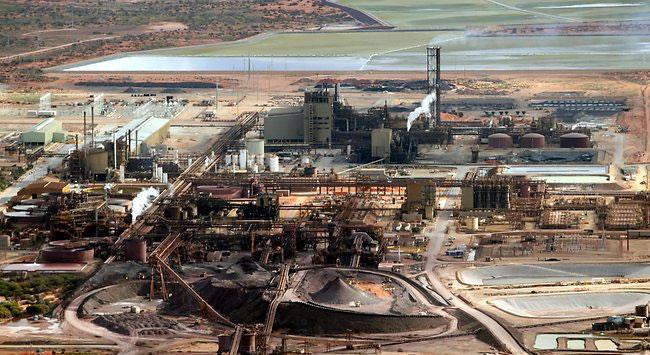
Over 80% of the world's supply was gen erated in China over the last two decades. Because of China's ability to exploit REE supplies as geopolitical leverage in trade disputes due to its near-monopoly, efforts to diversify production have increased.
Reserves of Rare Earth
Almost all known REE occurrences are connected to uncommon forms of magmatism. The majority of the world's resources are contained in, or closely related to, carbonatites or alkaline igneous rocks, as well as heavy mineral sands produced by the erosion of these rocks. Mining faces difficulties as a result of this lack of diversity.
Most of the REEs in alkaline rocks are found in silicate minerals, which are difficult to impossible to commercially process with existing technology. In contrast, carbon atite deposits, which are more economically viable, are rich in LREEs but very poor in the more desirable HREEs. The majority of the world's HREEs come from deposits of ionic-absorption clay that are created when granites rich in REEs weather in tropical regions. These deposits, which vir tually exclusively occur in southeast Asia (mostly China), contain only tiny amounts of resources that are quickly running out. In the long run, there are lots of LREEs available, but HREEs may not be as plentiful.
Tol Weld
With proven and probable reserves of 19.7 Mt at 8.6% total rare earth oxides (TREO) and measured, indicated, and inferred resources of 55.4 Mt at 5.4% TREO, Mt Weld, Australia, is one of the largest and highest-grade REE deposits in the world. Mine should last for at least 25 years.
The project also contains the undeveloped Duncan (REE), Crown (niobium, tantalum, titanium, REE, zirconium), and Swan (phos phate) resources, albeit only the Central Lanthanide Deposit is now mined. The Lynas Rare Earths Corp. is the project's owner.
The 66 Kt/year of REE concentrate that Mt Weld generates is sent to Lynas's process ing facility in Malaysia for processing. Due to the creation of radioactive waste, this plant has generated controversy, yet, the Malaysian government recently renewed its operational license.
Although this will be an addition to existing offshore processing rather than a replace ment, Lynas is currently building a new processing facility in Australia.
Mt. Weld is a rare, more than 50% carbon ate-bearing igneous rock called carbonatite that is two billion years old and has under
Due to the rarity of the deposits and the expensive, time-consuming, and frequently environmentally damaging ore processing, it has been difficult to develop a reliable supply of the strategically and economically important metals.
Olympic Dam, South Australia.
LEAD
10 | SKILLINGS MINING REVIEW October 2022 THE
gone extensive weathering. By disintegrating the once-solid ore, this weathering has improved the carbonatite, which was already rich in REEs, into one of the highest-grade deposits in the world and made the deposit easier to mine. Although some HREEs are found, Mt. Weld produces mostly LREE, like the majority of carbonatites.
Olympic Dam
The largest copper, gold, silver, and uranium mines in the world are located in Olympic Dam, South Australia. Olympic Dam contains low-grade REE mineralization (mostly LREE), like many other Iron-Oxide-Copper-Gold (IOCG) deposits. This makes Olympic Dam, with resources of about 2000 Mt at 0.5% REO, one of the greatest REE deposits in the world due to the massive magnitude of the deposit. BHP Billiton is the owner of the project.
At Olympic Dam, REEs are not yet recov ered. There have been numerous ideas to recover REEs as a byproduct, but since most of them are the low-value LREEs lanthanum and cerium, it would require a substantial investment in new processing facilities and is unlikely to happen very soon.
Eneabba
Approximately $1.5 billion REE refinery will be built at Iluka Resources' Eneabba project in Western Australia as part of the company's goal to expand into the REE industry. Iluka Resources has previously largely produced mineral sands.
By 2025, the refinery is anticipated to pro cess 17.5 kt/year of REO. For construction financing, Iluka has obtained a $1.25 billion loan from the Australian government.
The plant is intended to process feedstocks from other projects. However, it will initially treat Iluka's stockpiles of REE-bearing min eral sands, which have an anticipated lifespan of 10 years. REE sands from Iluka's Wimmera Project in Victoria, Australia, might also be processed at Eneabba.
Yangibana
Hastings Technology Metals obtained a $100 million government loan earlier this year to start working on its $500 million Yangibana Project in Western Australia. Measure, indicated, and inferred resources total 21.67 Mt at 1.17% TREO, with proven and probable reserves at 10.35 Mt at 1.22% TREO.
Neodymium and praseodymium, two of the more sought-after LREEs, will be the mine's primary targets. Hastings has agreements in place to export 6 Kt of REE concentrate annually for processing in China. After Mt. Weld, it would be Australia's second-largest producer of REE.
The majority of the rare earth elements (REEs) are hosted in the mineral monazite, which is present in several narrow iron stone dykes that are 1.3 billion years old and associated with carbonatite.
The Brockman Project in Western Australia, owned by Hastings as well, contains 52 Mt of 0.22% TREO (85% of which are HREEs), along with 0.39% niobium oxide and 0.95% zirconium oxide.
Dubbo
At the Dubbo Project in New South Wales, operated by Australian Strategic Metals (ASM), there are proven reserves of 18.9 Mt at 0.871% TREO, plus 1.85% zirconium oxide, 0.04% hafnium oxide, 0.440% niobium oxide, and 0.029% tantalum oxide, as well as measured and inferred resources of 75.18 Mt at 0.88% TREO, plus 1.89% zirconium
 Illustration of how the Wolverine Deposit formed.
Illustration of how the Wolverine Deposit formed.
www.skillings.net | 11
oxide, 0.04% haf It is now a premier rare metals deposit in the world. The mine life is anticipated to be at least 20 years, and the project is getting ready to start development. It will produce 1 Mt/year from an open pit. In South Korea, a processing facility is anticipated to be built.
Trachyte, a subvolcanic alkaline rock, makes up the deposit's sill. Although the silicates, carbonates, and oxides that make up ore minerals are varied, ASM thinks the ore can still be treated rather simply.
Blacks Range
In recent years, a number of REE deposits have been found in northern Australia's Browns Range. The Wolverine deposit, owned by Northern Minerals, is the largest of them and has resources of 4.97 Mt at 0.86% total REEs. While generally not spectacular, Wolverine's high percentage (89%!) of HREEs + Y makes him a unique and fascinating find.
In order to extend the potential mine life, Northern Minerals has finished a pilot processing facility and is now looking for additional near-surface resources at Wolver
ine and other deposits. Like other deposits in the region, Wolverine's ore is composed of quartz-xenotime veins and breccias that are 1.65–1.60 billion years old and are located in sharply dipping fault zones.
The deposits in the Browns Range appear to be of a brand-new type called uncon formity-related REE deposits. These REE deposits, unlike the majority of them, are hydrothermal in origin and have no known connection to magmatic processes. Due to how difficult it is for fluids to carry REEs regularly, hydrothermal REE deposits are extremely infrequent.
In order to leach REEs from metasedimentary rocks, fluids involved in the Browns Range deposits appear to have been exceptionally acidic and rich in chlorine and fluorine. Why these ore-forming fluids are so much higher in HREEs than LREEs is unknown.
Once inside fault systems, these REE-con taining fluids were able to cross the unconformity separating the metamorphic rocks from the underlying sedimentary rocks. Due to interaction with a fluid made of phosphorous from the sandstones above,
this caused ore to deposit. Due to phospho rus' high reactivity with REEs, minerals like monazite and xenotime will form as a result.
The Maw Zone, the only other known analogous deposit, is connected with uncon formity-related uranium (U) deposits in the Athabasca Basin, Canada. Overall, this pro cess is very similar to unconformity-related uranium (U) deposits.
Investor Takeaways: Is Chinese REE Dominance coming to an end?
China continues to dominate the production of REEs worldwide, accounting for 60-80% in 2021. (the uncertainty is due to illegal and undocumented mining). However, this is less than a decade ago when it generated about 95%. On the other side, Australia has increased from 0% to 7% in the same period and could produce up to 30% of the world's REEs in the next years.
With the reopening of the Mountain Pass mine in California, America has also reemerged as a significant producer. It appears that the Chinese government has taken note, as they have been charged with utilizing deceptive marketing practices and disinformation efforts to harm foreign producers.
Since there didn't appear to be many other sources of these rare elements up until recently, the discovery of deposits rich in HREE may prove to be of great significance. It remains to be seen if these unconventional reserves can be successfully developed.
Weld
Despite the fact that some of these Austra lian projects are still years away from going into production, the discovery of so many potentially viable deposits of various types, along with the significant investments made in domestic processing facilities, suggests that Australia's REE mining industry may be in for some exciting times in the future.

Geology of the Mount
Project 12 | SKILLINGS MINING REVIEW October 2022 THE LEAD
HALCOR PRODUCTS
Copper tubes with or without lining or industrial insulation for applications in:
• Drinking water and heating networks
• Underfloor heating and cooling
• Gas and medical distribution networks gases
• Cooling and air conditioning systems
• Solar energy applications
• Various industrial applications
Halcor is the copper tubes division of ElvalHalcor S.A. and together with four more companies form the copper segment of ElvalHalcor S.A. that specializes in the production, processing and marketing of copper and copper alloys products with dynamic commercial presence in the European and global markets. For more than 80 years, Halcor has been offering innovative and added-value solutions that meet contemporary client demands in fields, such as plumbing, HVAC&R, renewable energy, architecture, engineering and industrial production.
The copper segment of ElvalHalcor S.A. is composed of six subsidiaries and seven associates/joint ventures, based in Greece, Belgium, Bulgaria, Romania and Turkey, while it operates a total of five production plants in Greece, Bulgaria and Turkey.
The copper segment of ElvalHalcor S.A. develops and distributes a wide range of products, including copper and copper-al loy rolled and extruded products with Halcor being the sole producer of copper tubes in Greece. High quality in production

is achieved through strict controls applied throughout the production process. With a consistent quality focus, the company implements an ISO 9001:2015 Certified Quality Management System and leverages high technologies and expert staff.
As a result of the Group’s strategic invest ments in research & development, Halcor is recognized as one of the leading copper producers globally, setting new standards in copper processing. The company main tains a consistent focus on quality and

environmental protection and a strong commitment to the principles of sus tainable development. In this context, all production facilities in the Group’s plants leverage advanced technologies to bring in the market innovative products that are energy efficient and environmen tally friendly.
For more information, please visit our web site www.halcor.com
www.skillings.net | 13
India: Sandvik Mining Automation Learning Center Opened

thE sAndvik Mining AutoMAtion lEArning cEntrE (sMAc) wAs established on the campus of IIT Indian School of Mines (ISM) in col laboration with Sandvik Mining and Rock Technology, India, to provide the mining sector with educated and skilled labor for mine automation.
The center was officially opened by Prabhat Kumar, Director General (DG) of the Directorate General of Mines Safety (DGMS), who was highly pleased with the IIT's initiative (ISM). Markus Lundgren, the Sweden embassy's economic and commercial adviser, Prof. Rajiv Shekhar, the director of IIT (ISM), Kiran Acharya, the managing director of Sandik Asia Private Limited, Asoktaru Chattopadhya, the country head and president of Sandvik Rock Processing, Manojit Haldar, Sandvik Mining and Rock Technology India, and Dhiraj Kumar, the deputy director of IIT (ISM), who is also the project director of TEX.
Prof Rajiv Shekhar, Director, IIT (ISM) Dhanbad who also is the chairman, Hub Governing Board, TEXMiN Foundation
Markus Lundgren, Economic and Com mercial Counsellor, Embassy of Sweden in India said ,"the centre is an excellent example of bilateral cooperation between India and Sweden. The main purpose is to produce mining engineers having knowledge of the latest mining technologies that make underground mines more safe as well as automated in future".
DGMS DG Prabhat Kumar, the event's key note guest, stated at the event's opening remarks that the mining industry's primary need is for skilled labor since it provides more effective and safe mining. He applauded IIT (ISM) Dhanbad, India, for taking the ini tiative to open the center to deliver the most outstanding talent and automation in the mining industry.
Insider Buys Anglo American plc Shares Worth
£173.28
Anglo AMEricA n plc insidE r Tony O’Neill acquired six shares of the stock on September 14, 2022 in a deal. The shares were bought for a total of £173.28 ($209.38) i.e. an average price of GBX 2,888 ($34.90) per share.
AAL shares increased in value by GBX 13 ($0.16) thereby reaching GBX 2,828.50 ($34.18). Compared to its usual volume of 3,491,150; the company’s stock had a trading volume of 2,447,067 shares. The compa ny’s fifty-day and 200-day moving average prices were GBP 2,818.05 and GBP 3,355 respectively.
The fifty-two-week low for Anglo American plc is GBP 2,350 ($28.40) and the fifty-twoweek high is GBP 4,996.80 ($60.38). The company has a debt-to-equity ratio of 37.42, a quick ratio of 1.28, a current ratio of 1.90, and a quick ratio of 1.28. The market capi talization for the company is £37.83 billion and the price-to-earnings ratio is 570.87.
Recently, the company announced a divi dend that would be paid on September 23. Shareholders of record on August 18 will be given a $1.24 dividend. This amounts to a 3.71% yield. Presently, the payout ratio for Anglo American plc is 58.27%.
scan the qr code to read the full story on our website
DGMS director general inaugurates Sandvik Mining Automation Learning Centre (SMAC)
14 | SKILLINGS MINING REVIEW October 2022 MINING FINANCE
Shaft sinking innovations, safer workplace by 2040
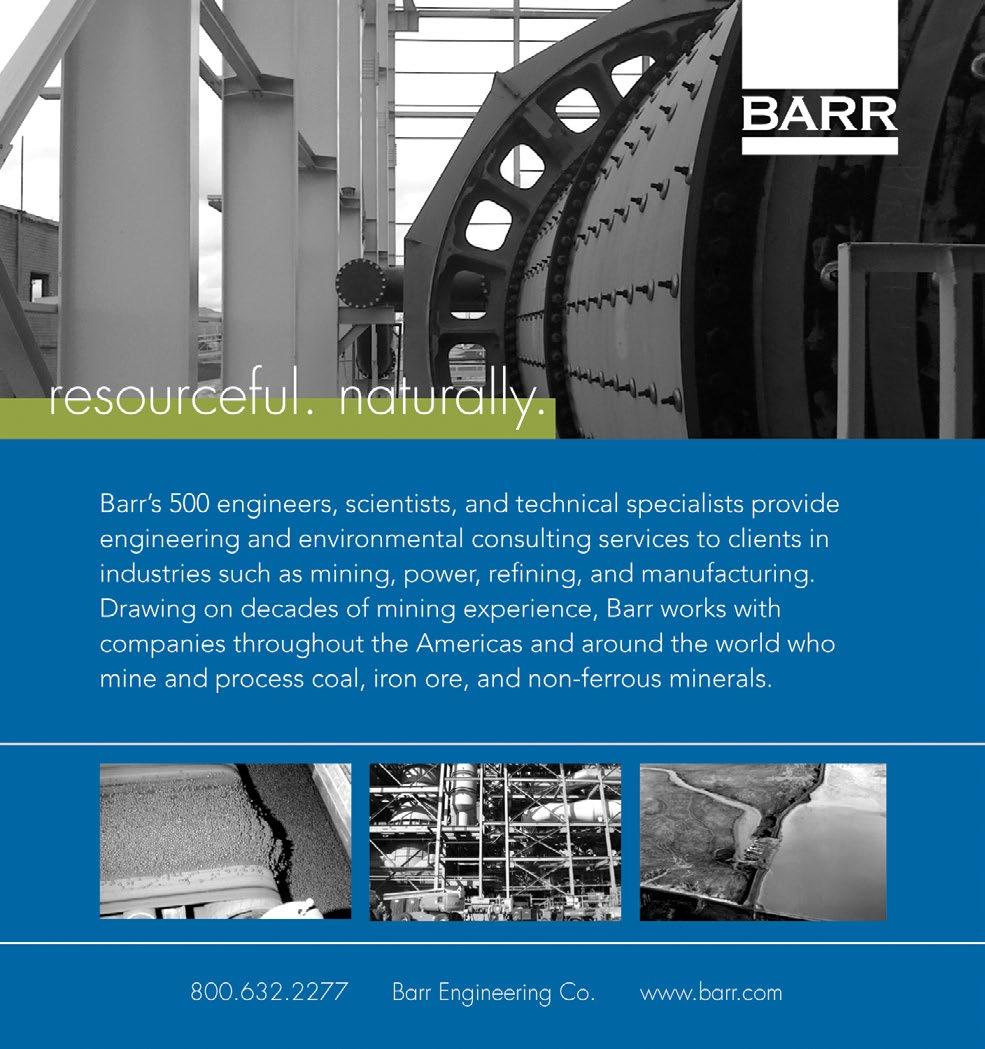
Lucara Diamond Corporation or Lucara has earned over 120.5m USD in diamond sales for the past six months from the Karowe mine located in Botswana.
They have also decided to start shaft sinking in order to make a transition from open pit to underground operations. This mine has been operating for the past 10 years. The shift will further extend the life of the mine through 2040. “The estimated capital cost of the underground project has been increased from $534m to $547m “to
reflect expected pricing changes following execution of the main sink contract,” Eira Thomas, Karowe CEO said.
He also added that the mine ramp-up is expected in the first quarter of 2026 with full production from the Karowe UGP (under ground project) expected in the second half of
2026. Lucara is expected to spend a total of 110m USD on this shaft sinking project but they will not need to pay any tax for the year 2022 because of Botswana’s pro gressive tax rate computation.
scan the qr code to read the full story on our website
∙ Mineral purchase agreements, leases and options
∙ Land assembly and mineral rights acquisition
∙ Severed mineral registration and title work
∙ Environmental permitting and compliance
fryberger.com
Equipping the mining industry with legal services since 1893.
Paul Kilgore
Paul Loraas
››
››
° MINING & MINERALS LAW °
www.skillings.net | 15
Mining Technology Inculcation: Australia a Trendsetter!
businEss AnAlysts prEdict thAt tEchnology will coMplEtEly transform the mining industry in Australia. According to a 2019 analysis commissioned by the Minerals Council of Australia (MCA), technology advancements will affect more than 77% of jobs in the country's mining sector over the next five years, potentially boosting productivity by up to 23%.
A ustralia's education and training mechanism will require to undergo a change in order to get there, fusing mining expertise with "the newest scientific, technical and trade skills," including data analytics, computers, and change management.
After experiencing a decline from 2009 to 2013, mining productivity has shown favor able trends, with gains primarily attributable to lower capital expenditure (capex) and operational expenditure (opex).
According to a report from McKinsey & Company, 2020, increases in output are
likely to keep the Australian region at the forefront of the adoption of new technologies.
Adoption of new technologies, especially autonomous ones, without taking end-to-end mining throughput into account, is at best difficult and, at worst, indicates a failure of the business. Before implementing a tech nology upgrade, it would seem reasonable to view the "whole mining process" as an engineered system in which all components should be prioritized. However, this has not always been the case.
A notable success story was Rio Tint's Pilbara iron ore mine, which used 80 driverless trucks in 2008 and saw significant pro
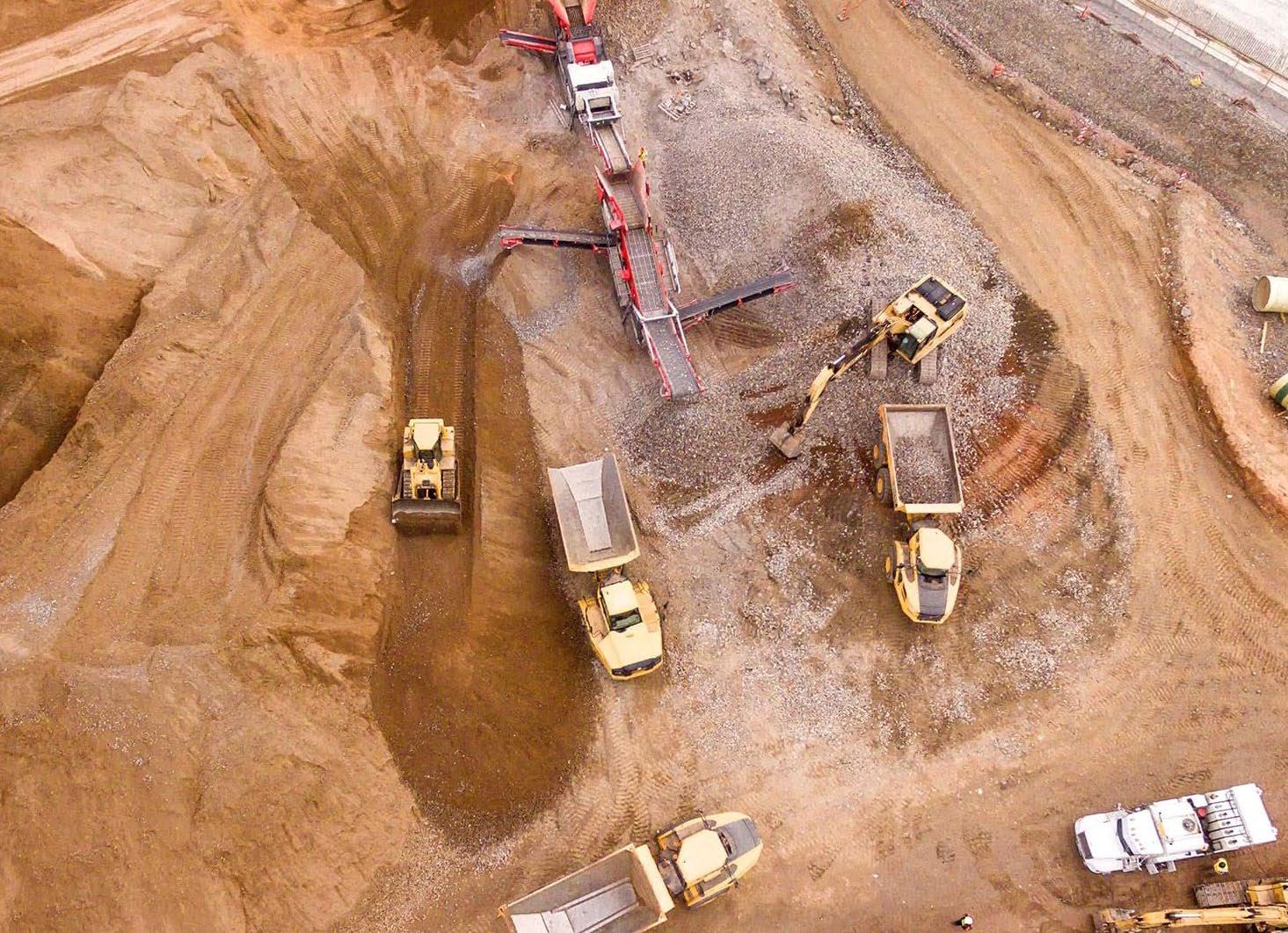
16 | SKILLINGS MINING REVIEW October 2022 SURFACE MINING
duction gains. Following suit, BHP Billiton and Suncor did the same, and the presence of Caterpillar, Sandvik, Komatsu, and Atlas Copco continues to drive innovation in auton omous vehicles. Additional semi-automated or automated equipment is also planned for or already in use in Australian coal and mineral mines, frequently with the assistance of remote operations centers located in or close to capital cities.
Contrarily, the full scope of change necessary in management systems and organiza tional culture has not always been taken into account when introducing any new technology, automated or semi-automated equipment, or mining process.
FAILURE SIGNS ARE FREQUENTLY MOST APPARENT WHEN:
In equipment support due to shortages of parts and maintenance/repair expertise.
A lack of pertinent facts to enable sound decision-making, as well as an abun dance of data that can cause "paralysis by analysis."
By staff members' disengagement with newly introduced technology, which results in subpar safety outcomes, subpar system performance, or inability to meet even the most fundamental production improvement goals.
Other drilling types have not been success fully automated, despite some subterranean rigs making headway in that direction, while blast hole drilling and offshore oil drilling have. While some manufacturers' land-based exploration drilling rigs offer hands-free drill pipe/rod handling, hands-free core barrel handling is typically not an option.
Automation has not yet been able to handle the large range of wellbore sizes and kinds that land production drilling rigs deal with. Due to the high value of the wells and the resource, oilfield rigs, particularly offshore rigs, have had either semi-automation or complete automation for at least ten years.
Drilling is just one step in the value chain of onshore exploration that involves finding, comprehending, and classifying a resource. Customers frequently do not view the lack of technology in the drilling function as a problem since they would rather focus on higher-value tasks like core analysis or min eral grading technology.
The installation of the final casing and fin ishing the wellbore have a significant impact on drilling for production, or the installation of dewatering, gas risers, and other similar devices, meaning that drilling itself has a lesser role in the process.
Directional drilling requires a delicate mix of strength and dexterity, and it depends on a reliable geo-model for wellbore design and execution. In the last three years, the use of oilfield technology has allowed integration of geological sensing instruments with a deeper level of research into the drilling assembly, providing better insight into the
correctness of geological models and assist ing with improved drilling decision-making.

When it comes to wellbore length, diame ter, or information needed for the drilling process, drilling clients frequently look for innovations that push the envelope of what is achievable. Although automation is frequently brought up, it hasn't been given much weight in drilling-related final decisions. Instead, in order to produce more useful data from the drilling process, mine operators are concentrating on safety and technological advancement.
Lucas, AJ
Since the drilling industry started in 2000, Lucas has accumulated a vast amount of experience and has been actively involved in the most cutting-edge drilling advancements for underground mining, directional drilling, and production wells for water and gas. To assist the business and promote the adoption of designed technology, Lucas
www.skillings.net | 17
tool technology. By actively interpret ing "as-drilled" geology, comparing it to modeled geology, and making real-time wellbore changes, experienced employ ees can actively direct the well toward the intended geological horizon by using real-time sensing data. If necessary, geo-steering can be done remotely or on the rig site.
By designing boreholes without on-site welding, a major supplier and I created big-diameter threaded casing, which con siderably shortened installation time. In the past, a borehole had to be left open for extended periods while the liner casing was installed and welded, which increased the chance of a wellbore collapsing and, in the case of an underground mine, the amount of groundwater that needed to be handled. Threaded casing connectors with a large outside diameter shorten installation time from weeks to days.
created an internal drilling engineering and directional drilling service over the course of the past 22 years.
For data-driven decision-making and suc cessful client outcomes, Lucas Drilling concentrates on the combination of engi neering experience and adequately updated technology.
IMPROVEMENTS IN ENGINEERING-BASED TECHNOLOGY THAT HAVE BEEN EMBRACED INCLUDE:
Rack and pinion rigs, which were intro duced in 2004 and have now evolved into high-capacity, PLC-controlled rigs with a drilling depth of more than 3000 metres. The larger capacity rigs are utilized for gas drainage and enable the deploy ment of the geological sensing tools to greater depths as part of a structured data collecting strategy to support better
mineable horizon planning. These rigs are typically employed for extended-reach lateral directional drilling.
Planning drilling programs and leaving the field team to carry out operations has evolved into a closed loop plan, drill, check, and adjust process with a head office drilling engineering staff to support real-time decision-making on the rig.
Off-site directional control, where appli cable, has increased efficiency by enabling a single directional drilling specialist to assist numerous rigs. Real-time data col lection and data from downhole drilling tools broadcast through a secure network created in collaboration with the down hole equipment supplier assist off-site operations.
Geo-steering has been made easier by the integration of rig data acquisition and advancements in downhole geo-sensing
Casing packers with a large diameter that enables high-quality casing cement ing, especially on breakthrough holes, considerably decreasing underground contact and speeding up completion times. Traditionally, the initial cement seal is laid from beneath, and a staged cement seal is installed from the surface to complete the wellbore where wellbore liners penetrate into underground workings. A single pass cement operation can be pumped and finished faster when a bigger diameter casing packer is used.
If the value added to the drilling process justifies it, new technology will continue to be a blend of engineering solutions, progressing toward semi-automation and eventually complete automation.
The "trickle down" effect of other automa tion techniques and technology, especially where mining operators are experiencing demonstrated benefit, will offer the customer pull to balance the supplier push and should produce an output that is fit for purpose.

Before implementing a technology upgrade, it would seem reasonable to view the "whole mining process" as an engineered system in which all components should be prioritized. However, this has not always been the case.
18 | SKILLINGS MINING REVIEW October 2022 SURFACE MINING
Slam Exploration Mobilizing to Drill Gold Veins at Menneval

SLAM Exploration Ltd. (“SLAM” or the “Company” on TSXV: SXL) is pleased to announce it is mobilizing a diamond drilling rig a drilling program on its whollyowned Menneval gold project located in the mineral-rich province of New Brunswick, Canada. The rig is to be transported over the weekend, with drilling expect to start on or about Monday, September 19, 2022.
The slam exploration intends to drill up to
1,000 metres in approximately 10 holes to test 2 gold zones discovered by SLAM in 2020-2021. This includes up to 6 holes on Zone 18.
These holes are planned to test for extensions beneath core intervals grading up to 162.5 g/t gold over 0.2 m and 56.50 g/t gold over 0.51 m associated with visible gold in holes reported by the Company on December 03, 2020, and January 20, 2021. Previously, the
Company had announced multiple sites of visible gold with assays up to 3,955 g/t gold over 0.10 m thick from trench samples reported on December 03, 2020.
scan the qr code to read the full story on our website
Proud to be your reliable partner.
We have long supported the region’s mining industry by providing safe, reliable and competitively priced electricity. In 2021, half of the energy we provide to all of our customers will come from renewable sources.

Together, we power northeastern Minnesota’s economy.

www.skillings.net | 19
mnpower.com/EnergyForward 19260
Viscount Mining TITAN MT Survey Confirms Conductive Anomaly at Silver Cliff, Colorado

As vErifiEd by QuAntEc gEosciEntists, thE rEsults of thE titAn Mt survEy conductEd by vis count Mining Corp. on Passiflora in Silver Cliff, Colorado revealed a huge system of interconnected min eralized fractures likely indicating porphyry.
During the early summer of 2022, Quantec Geoscience had been contracted by Viscount mining to perform a five-line TITAN MT survey over the Silver Cliff caldera of the Passiflora target. The goal of the survey was the identification of conductive areas below the survey surface which could potentially represent metal deposits or the presence of porphyry.
Quantec is authorized by the Association of Professional Geoscientists of Ontario (PGO). Its roster of clients includes New mont Mining, Barrick Gold, Agnico-Eagle Mining, De Beers Consolidated Mines Lim ited, and the Nevada Department of Energy amongst others.
For the current project, each of the 5 parallel lines surveyed by Quantec were 2.2 kilome ters (1.36 miles) in length and separated by 175 meters (574 feet). Ground-penetrating resistivity data was gathered overnight from each survey line. This data was analyzed and converted into cross sections.
TITAN MT survey identified extremely low resistivity zone
In their executive summary, Quantec declared that: “The TITAN MT survey identified a zone of extremely low resistivity in the Silver Cliff caldera.
The main anomaly is bowl-shaped and at a depth of ~450m (~1475 ft) at the point nearest to the surface below lines L1E and L2E… The 2D and 3D modeled depth of the anomaly extends ~1500m (~4920 ft) deep, or to an
An aerial image showing locations of the five TITAN MT survey lines positioned over the Silver Cliff caldera.
elevation of ~900m (~2950 ft), but the source could be deeper. The extreme conductivity of the anomaly and sensitivity of the MT method limit resolution of the inversion result below the massive conductive zone.”
Viscount CEO Jim MacKenzie commented, “In response to these extraordinary findings,
Viscount is currently putting together a drill program aimed at determining the compo sition of the very high conductivity source.
Quantec Geoscience stated this is one of the lowest resistivity anomalies they have ever seen. The Quantec survey shows that the geophysical foot print has the indication
SURFACE MINING
20 | SKILLINGS MINING REVIEW October 2022
that we are looking at a potentially signifi cantly large mineral system at the Passiflora.” Talking about the structure of the anomaly, Quantec added: “there are branches oriented in a roughly E-W direction that come closer to the surface to ~320m (~1050 ft) depth below lines L4E and L5E in the south-eastern part of the grid. These branches could be related to fault-controlled mineralization or alteration.”
The only historic report about the Passiflora target was written by R. A. Rivera for Coca Mines in 1983. In this report, Rivera outlined a brief history of exploration efforts in the area and had inferred a potential deposit size of 40 million tons of AgEq in the form
of silver, gold, lead, and zinc (not NI 43-101 compliant). This report stated that the deposit was presented as “a set of steeply dipping, NNW striking, tabular mineralized zones” (Rivera, 1983).
It was also implied that the deposit could possibly go much deeper as Rivera had high lighted that some drill holes presented high assay values at their total depths.
Viscount mining has drilled six drill holes throughout the Passiflora target.
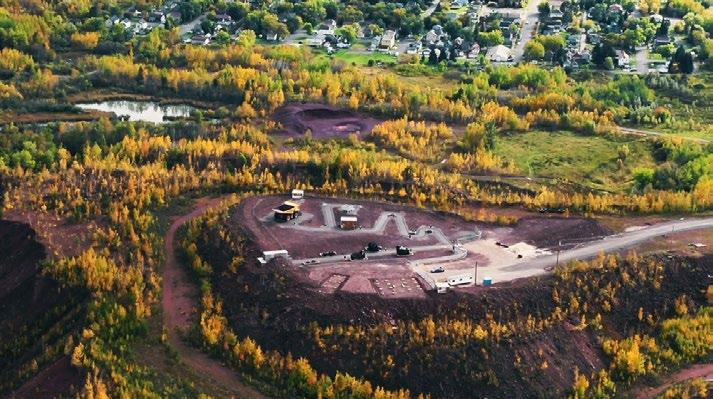
The deepest of these goes 215m (705 ft) below the surface. Evident phyllic alteration and associated metal concentration increases
were observed throughout the entire drilled depth in each of the six holes.
Viscount Mining was inclined to further explore the probability of the Passiflora target presenting as porphyry at depth because of the level of increased alteration displayed along with the volcanic history of the region as a caldera. Jacob Hooker, Silver Cliff Exploration Manager emphasized that: “This caldera is one of at least ten eruptive centers of the Central Colorado Volcanic Field (CCVF). Four of these ten have been further classified as silicic eruptive centers, of which the Silver Cliff caldera is one (McIntosh and Chapin, 2004).

SOLVING YOUR MOST COMPLEX CHALLENGES. With SEH, you are a true partner and collaborator. Engineers | Architects | Planners | Scientists 800.325.2055 | sehinc.com/subscribe
www.skillings.net | 21
Novel Self-Propelled Bale Chaser: Contractor Work
coming up with creative solutions to hauling hefty straw bales more effectively for years.
High-capacity grabs, trailers with hydraulic sides for securing loads, and several sophisticated chasers for gathering and stacking without the need for a loader are the results of their efforts.
Nevertheless, Joe Williams of Eastern Counties Straw believed that there was still opportunity for growth. He had been using 16-bale Heath Super Chasers for some time, but he was looking for a quicker and more dependable way to corral the 120x90cm bales that his eight-string Krone balers were producing.

His initial effort was to design a massive trailed chaser with a tri-axle chassis that could hold 32 bales in a single load, dou bling capacity.
Even with a 300hp Fendt up front, it oper ated reasonably well but was too heavy to pull in anything but bone-dry conditions. Instead, he shifted his attention to improving the efficiency and dependability of the task of collecting 16 bales. Instead of creating a
device to pull behind a tractor, he chose to create a self-propelled bale collector based on an eight-wheel lorry to do this.
Although he had seen single-row stacks con structed in the US and Australia, he believed he could accommodate a double row on the back deck. After a few sketches and a few miniature mock-ups, Mr. Williams entrusted the construction to engineering genius Tim Ansell, who owns the sibling company of Eastern Counties Straw, JW Fabrications.
However, Mr. Ansell has been producing and repairing agricultural machinery for the company for the past 15 years (see "JW Fabrications" below). Mr. Ansell got his start building and maintaining the gold mining equipment.
The project was prepared for testing during the 2021 season, but it has been success fully moving more than 4,000 bales this year. The engineering division of Eastern Countries Straw, JW Fabrications, special izes in creating, modifying, and maintaining
agricultural equipment. While it performs some jobs for farmers and other contractors, most of its work is for the straw industry. Previous initiatives include a silage elevator that enables corn to be loaded into trucks parked on the side of the road to prevent mud from getting on the road.
The first was created for the company's internal usage, but they decided to create a few more due to its popularity. It has since created a new version based on a sizable snow blower.
This has the advantage of an adjustable spout, allowing for the even loading of trailers with out the need to shunt them back and forth.
Tim Ansell and his team of engineers also developed a special service trailer for the
fArMErs, contrActors, And EQuipMEnt MAnufActurErs hAvE bEEn
Photos: fwi.co.uk/ © James Andrews
22 | SKILLINGS MINING REVIEW October 2022 MINING EQUIPMENT
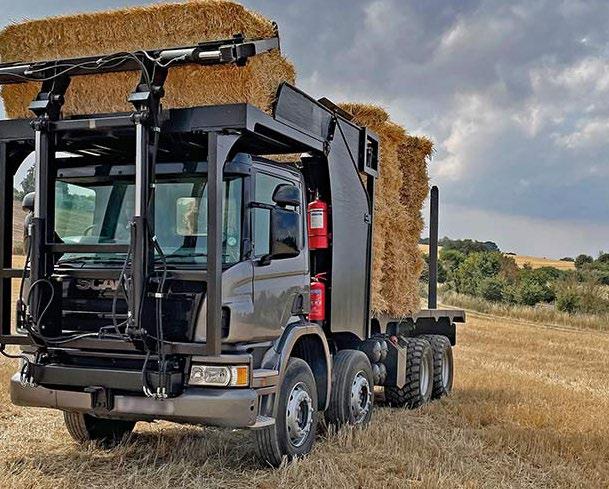
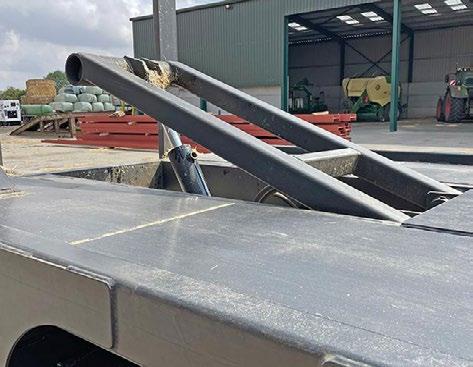
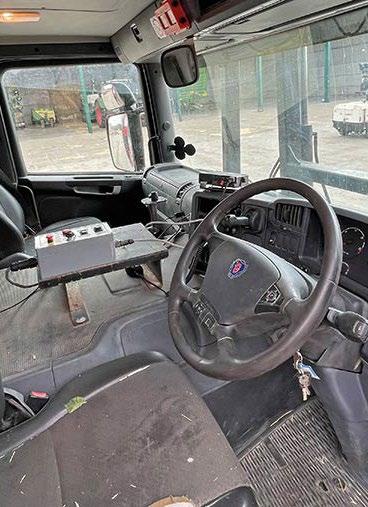

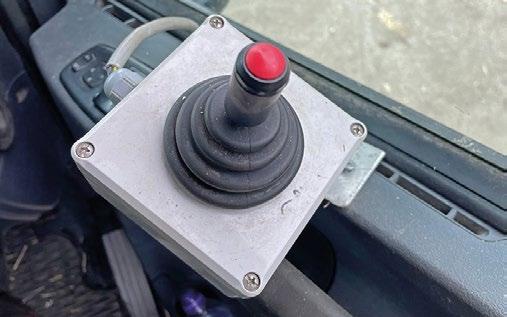
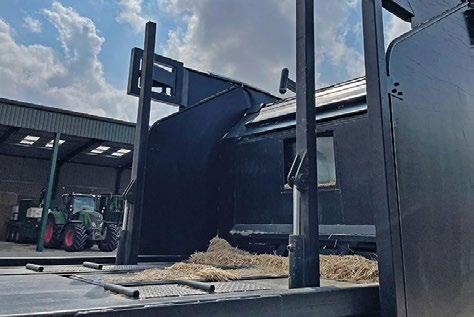
www.skillings.net | 23
MINING EQUIPMENT
company to accompany them while on the maize campaign. Based on a tri-axle chas sis, it has room for a 10,000-liter diesel tank, AdBlue storage, generator, telescopic floodlight, two pressure washers, a full com plement of tools, and of course, a gas grill.
What it does
A hydraulic arm at the front of the truck picks up bales and puts them onto a platform with hinges on the cab roof. Then, at the front, it is raised, creating a slope down which the bales slide before falling on their side on the back deck. A second bale is dropped on top of the first, creating a double layer, and is then pushed down the bed by a hydraulic headboard to make room for the following pair.
Hydraulic fingers lift out of the truck to anchor the first row of bales as they settle into position, preventing them from tip ping over. These then descend once more, enabling the bales to be pushed back. This accommodates eight rows, resulting in a total capacity of 16 bales.
The entire bed is tilted upward during unloading so that the bales can be placed upright. To step the top half of the weight and create a more stable stack, a few flaps pop out of the floor simultaneously. Additionally, a hydraulic arm is located at the base of the bed to assist in pushing the load into the stack as the driver backs up. It is easy to use because a single electronic joystick positioned on the driver's door controls all functions.
Faster Loading
The truck's capacity may be the same as that of the company's trailed chasers, but it can collect a lot more bales every day. There are several causes for this. First, the lorry is small and has good suspension, so it can easily squeeze through narrow openings and travel along rugged terrain without risking toppling bales or shaking the driver's teeth out.
If you want, you can sprint down the field at 50 mph, Mr. Williams says. The fact that it consistently produces stable stacks that hardly ever topple is the largest perk, though. The front loading arm, which centers each bale as it is taken up, is the key to this.
In contrast to many other chasers, which require some operator ability to poke the loading spike into the bale at the proper spot, there is no margin for error with this one.
Additionally, it uses less fuel than a tractor and trailed chaser, consuming only 200 liters for an entire shift.
Developing It
The 2013 Scania eight-wheeler dust cart with an up-and-over loader on the front served as the foundation for the lorry chaser.
The bale chaser project didn't employ any of the original mechanisms. Still, this model was appealing since it included a sizable spool block with air solenoids that could be used to power the intricate hydraulic services.
After stripping the truck down to its bare chassis, Mr. Ansell and his team started building the chaser. The loading arm was the first to be constructed, and because of its intricate geometry, a scale model was constructed before actual construction could start.
The arm's clever ability to move in a wide arc allows it to pick up a bale from the ground and then hoist it vertically so that it is at roof level. With a pair of connected hydraulic rams that ensure the bale is always fastened in the middle, the hydraulic gripper arm is also cleverly designed.
Additionally, the grab is weighted such that the bale falls back onto the roof platform when the arm is leveled up to its maxi mum height.
The main obstacle was getting the roof
platform to raise high enough for the bale to slide off and onto the rear bed because there was so little room for the rams to fit between it and the cab roof. The platform fires up quickly to knock the bale off its perch once they have managed to get the angles just perfect. The manufacturing of the rear load area was simpler than that of the front end. However, some of the little elements received considerable care.
These include the stack stepping plates in the base, some spring lugs on the side of the frame to prevent them from tipping forward, and the securing fingers that prevent the first row of bales from falling backward. All new steel was used in the construction, and an Esprit Automation profile cutter was used to cut several pieces.
Mr. Ansell does the CAD drawings for this project by himself. Therefore, not a lot of the labor was outsourced. With almost a dozen hydraulic rams on board, the team recruited some assistance to quickly install the device. Phil Nelson, a retired electronics engineer, and expert in hydraulics was given this task. He was successful in getting a tiny, computer-style joystick to communicate with the lorry's air solenoid spool block.
Installing an automatic fire suppression system with tubes that burst in the case of a fire and spray suppressant all around the machine served as the finishing touch.
In order to prevent flammable material from accumulating, they also had a custom-built tarpaulin manufactured, which is positioned at the back of the cab.
Modifications
The hydraulic system is now semi-automated and has a number of flow restrictors to allow some rams to move before others.
The next stage, according to Mr. Nelson, is to totally automate it, so that when the bale has been picked up, no operator input is
24 | SKILLINGS MINING REVIEW October 2022
needed. A reverse fan will also be installed on the truck as part of plans to keep it cool in dusty circumstances. The chaser may be simply unbolted and removed because it was designed as a demountable device.
Mr. Williams wants to equip the vehicle with a Bergmann muckspreader and perhaps a silage body so that it can haul grass in order to make better use of it.
Use in Agriculture
The truck can be operated by any operator and run on red diesel if it is registered as an agricultural vehicle.
To help spread the weight and improve the vehicle's performance on uneven terrain, the rear wheels have also been changed with large rims that are fitted with BKT 560/45 R22.5 tyres. It is intended to replace the stock 295/80 R22.5 tires on both front axles with 500mm tires, the greatest size that will fit without running the danger of rubbing during turns.
Although the vehicle does not have all-wheel drive, both of the rear axles are engaged, and a diff-lock is available if necessary. For the past two years, traction has not been an issue, and Mr. Williams believes it is capable
of handling ground conditions at harvest, even in years when the going is difficult.
Building custom
Since the design has been refined, JW Fabrications is willing to construct or hire out similar instances for other companies.
Prices will probably start at roughly £120,000 plus the cost of a donor truck. The 2013 Scania utilized on the first machine cost approximately £20,000 and had 100,000 miles on it. The chaser can be modified to work with bales of various sizes, but it is intended for 120x90cm bales.

www.skillings.net | 25 Industrial General Contractor Specializing in Equipment Installation and Maintenance crmeyer.com 800.236.6650 Offices: Byron, GA Escanaba, MI Muskegon, MI Coleraine, MN Tulsa, OK Chester, PA Oshkosh, WI Green Bay, WI Rhinelander, WI Millwrighting Piping Ironwork Concrete Electrical Building Construction Design/Build Offices Nationwide l l l l l l l Boilermaking l
Great Lakes Iron Ore Trade Down in August
Shipments of iron ore on the Great Lakes totaled 5.1 million tons in August, a decrease of 9.1 percent compared to a year ago. Ship ments were also below the month’s 5-year
average by 8.7 percent. Year-to-date, the iron ore trade stands at 24.2 million tons, a decrease of 24.5 percent compared to the same point in 2021.
Through August, iron shipments are 22.5 percent below their 5-year average for eight months of the year.
Great Lakes Iron Ore Shipments: August 2017-2022 and 5-Year Average
Includes Transshipments to Quebec City for Shipment Overseas (net tons)
Port 2017 2018 2019 2020 2021 2022 Average 2017-2021
Duluth, MN 653,815 753,097 1,034,173 784,565 1,132,118 783,957 871,554 Superior, WI 1,549,998 1,676,254 1,543,211 657,807 1,248,826 1,606,770 1,335,219 Two Harbors, MN 1,971,440 1,961,521 1,787,273 994,491 1,273,085 1,504,048 1,597,562 Silver Bay, MN 915,739 785,494 580,885 360,469 801,687 150,111 688,855 Marquette, MI* 790,977 765,107 806,181 510,505 728,542 748,384 720,262 Escanaba, MI** 0 0 0 0 0 0 0
Cleveland, OH*** 180,830 268,238 110,374 147,974 437,166 315,297 228,916 Ashtabula, OH 236,988 206,022 172,670 149,741 0 0 153,084
Total 6,299,787 6,415,733 6,034,767 3,605,552 5,621,424 5,108,567 5,595,453
*Marquette = Presque Isle in previous reports. **Dock ceased operations in April 2017. ***Transshipments within Cleveland Harbor Information is based on data from knowledgeable sources.
Year-To-Date 2017-2022
Port 2017 2018 2019 2020 2021 2022 Average 2017-2021
Duluth, MN 4,350,625 4,509,771 5,576,124 5,142,219 5,454,653 3,953,770 5,006,678
Superior, WI 7,477,377 7,886,178 7,036,717 4,210,602 7,394,740 6,974,867 6,801,123
Two Harbors, MN 10,215,368 10,098,301 10,541,206 7,709,362 9,476,573 8,092,503 9,608,162
Silver Bay, MN 4,056,312 3,960,752 3,177,212 2,311,974 3,373,700 1,013,474 3,375,990
Marquette, MI* 4,200,978 4,020,679 4,062,560 2,838,319 4,205,874 3,045,504 3,865,682
Escanaba, MI** 1,016,867 0 0 0 0 0 203,373 Cleveland, OH*** 1,899,257 1,764,640 1,483,492 1,542,625 2,099,557 1,107,183 1,757,914
Ashtabula, OH 618,940 790,350 912,701 548,380 28,553 0 579,785
Total 33,835,724 33,030,671 32,790,012 24,303,481 32,033,650 24,187,301 31,198,708
26 | SKILLINGS MINING REVIEW October 2022 STATISTICS



www.skillings.net | 27FloLevel Technologies
SPECIAL FOCUS

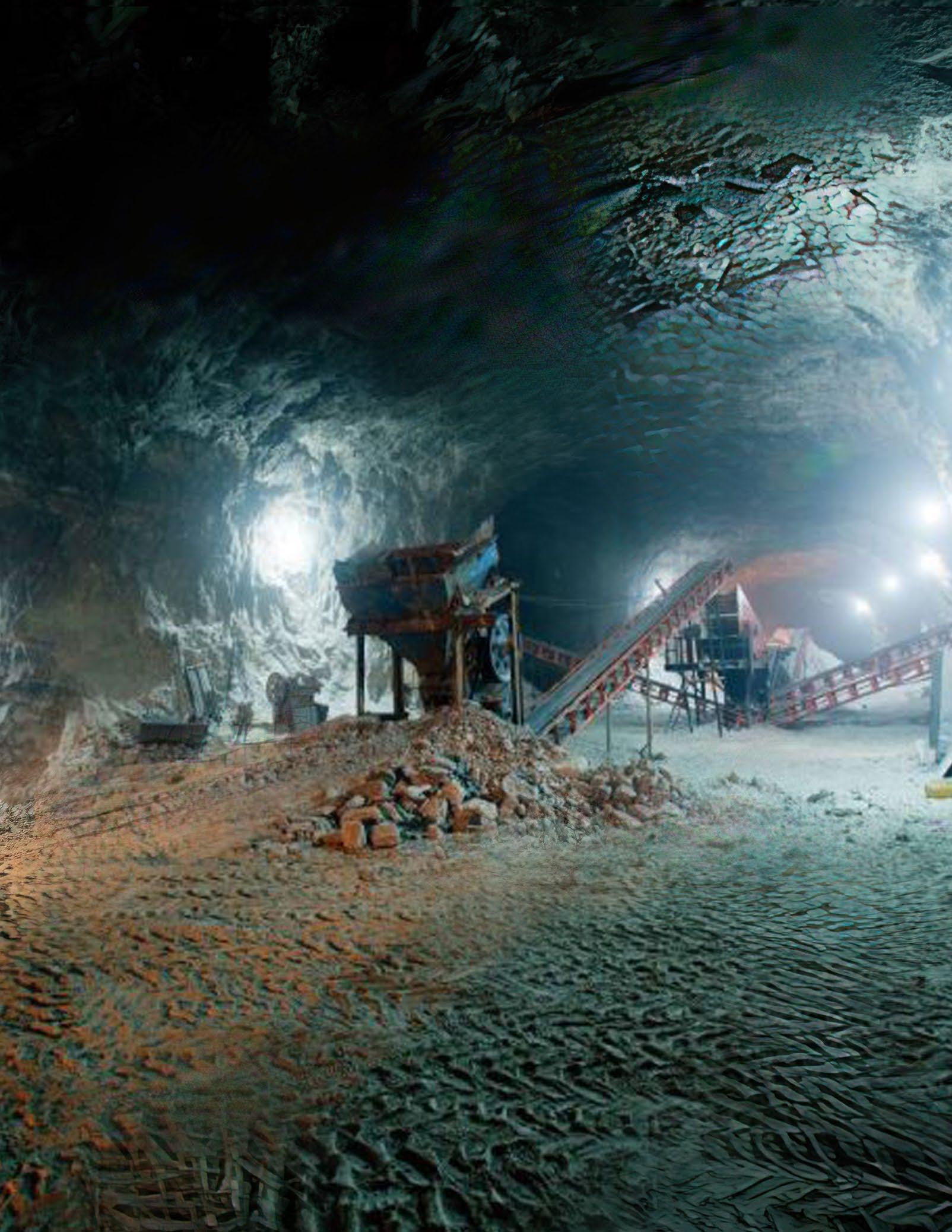 The Grängesberg mine, the central shaft headframe and enrichment plant, in the 50s.
The Grängesberg mine, the central shaft headframe and enrichment plant, in the 50s.
28 | SKILLINGS MINING REVIEW October 2022
Dalarna County, Sweden.
Grängesberg Iron Ore Resuming
After more than 150Mt of iron ore was produced, the Grängesberg mine in Dalarna County, Sweden, was shut down in December 1989 due to market conditions. One of northern Europe's largest homogeneous iron ore deposits are the mining deposit at Grängesberg.
I
n May 2014, the UK-based mining company Anglesey Mining signed a contract to buy a controlling stake in the project, including a direct 6% stake in the mine's Swedish owner, Grängesberg Iron AB (GIAB). Anglesey intends to reopen the project's mining operations.
In April 2012, a pre-feasibility study (PFS) for the Grängesberg mine was finished. The Swedish Mining Inspectorate granted the project a 25-year mining permit in May 2013. The business made a small investment in late 2019 and more investments throughout the years, which allowed it to obtain a 20% direct interest, managerial rights, and a right of first refusal to extend its position to 70% in the project.
A revised PFS with a 16-year life of mine (LOM) and a $559.6 million projected invest ment was released in July 2022.
The site of the Grängesberg mine
The project is situated in the central Swedish mining district of Bergslagen, 10 kilometers
southwest of Ludvika. The site's location is around 200 kilometers (km) northwest of Stockholm, the country's capital.
Underground iron ore mine: reserves and mineralization
The mineralization in Grängesberg is composed of apatite-iron oxide ore, which also contains a small amount of haematite (Fe2O3) and magnetite (Fe3O4).
Due to the oxidation of arid pegmatite sills and dykes, the northern portion of the deposit has greater haematite mineralization. With deeper drilling, the haematite content declines and gives way to pure magnetite. As of July 2022, it is predicted that the probable mineral reserves of the Grängesberg iron ore project will be 82.4Mt grading 37.2% iron (Fe) with a total iron content of 30.7Mt.
Mining techniques
The 2012 PFS assumed that historical sublevel caving would continue, while the amended PFS for 2022 suggested sublevel
open stopping with the backfilling of mined stopes for future designs.
Run-of-mine (ROM) ore will be transported to the underground crusher station, which includes a single toggle jaw crusher, a grizzly feeder to filter oversize material at 900mm, and an 80m3 feed hopper with a bypass channel.
The crushed ore will be moved from a vibrat ing feeder to a conveyor attached to the skip hoist, where it will then be transferred to surface stockpiles.
Processing
The project will contain a concentrator with an annual availability of 333 days (91%) and a processing size of 5.3Mtpa of ore at a notional processing rate of 666tph. The concentrator building is 40 meters wide and 150 meters long. It has a plant control room, utilities, reagent preparation, electrical switchgear, and numerous pieces of equipment for grinding, separation, flotation, and filtering.
www.skillings.net | 29
SPECIAL FOCUS
A primary crusher, primary autogenous grinding (AG), classification, and secondary semi-autogenous grinding will be included in the processing units (SAG). Solid/liquid separation, froth flotation, and magnetic separation will all be applied to the crushed ore. The tailings management facility will immediately store the unthickened tailings.
The piled-up ore will be discharged by vibrating feeders onto a conveyor belt that will feed the AG primary grinding mill. Peb bles from the AG mill will be collected by a trommel screen and used as grinding media in the secondary SAG mill.
The undersize will be sent to the primary wet low-intensity magnetic separators, and the screen oversize shall be recycled back to the AG mill (LIMS).
Before secondary grinding, the magnetite iron ore will be upgraded in the main LIMS stage. The haematite-containing non-magnetic slurry will be thickened and dewatered. To boost the haematite, the thickener underflow will be moved to a primary high-gradient magnetic separation consisting of SLon Vertical Ring and Pulsating High-Gradient Magnetic Separators (SLon VPHGMS).
Fine magnetite and haematite with a p80 size of 40µm will be produced by the sec ondary SAG mill when it runs in a closed circuit with a hydrocyclone cluster. The second stage of LIMS separators will be used on the hydrocyclone overflow, and the non-magnetic slurry containing the haema tite will be thickened and dewatered. The thickener underflow will be treated using SLon VPHGMS in a secondary high-gradient magnetic separation.
The magnetic separation concentrates' sulfur and phosphate content will be reduced in a reverse flotation circuit. The iron ore con centrate-containing flotation tailings will be thickened and dewatered. The dewatered filter cake from the thickened underflow
Key Project Metrics
THE KEY PROJECT METRICS ARE SHOWN IN THE TABLES BELOW.
Key Metric
Unit 2022 PFS Update
Ore to Mill Mt 82.3
Life of Mine Years 16.0
Contained Fe Mt 30.6
Recovery % 85
Recovered Fe Mt 26.0
Outgoing Concentrate Mt 37.2
Concentrate Grade % Fe 70
Average annual Concentrate Output Mt 2.3
Cash cost* US$/t Conc 53.60
All-in Sustaining Cost** US$/t Conc 57.80
Pre-production capital US$m 399
Post-tax NPV8% % 688
Post-tax Internal Rate of Return % 26
Project payback
Years 3.6
Average annual Post-tax Operating Cashflow *** US$m 130
* Cash costs are inclusive of mining costs, processing costs, site G&A, transportation charges to port and royalties
** All-in Sustaining Cost includes cash costs plus sustaining capital and closure cost
*** Post-tax Operating Cashflow based on iron ore price forecast of US$120/t China CFR 62% Fe benchmark
will then be transferred to a pellet factory for further processing to create iron ore pellets.
Infrastructure
The proposed site's surface infrastructure already consists of roadways, office buildings, workshops, and processing facilities.
The Grängesberg mine site is close to regional power lines and switchgear, and the project intends to use municipal power supplies generated by wind energy. It is suggested that most water supply comes from dewatered reclaimed mining water. The mainline railway is also on the property,
giving direct access to the 250 km south of the mine at Oxelösund port.
Contracting parties
Micon International, a mining consultant, was hired to create the project's 2022 PFS. The independent international engineering company URS Corporation undertook the PFS, which was finished in April 2012.
A geotechnical evaluation was carried out by the infrastructure consulting company AECOM as part of the 2012 PFS preparation process to examine the mine's stability, prof itability, and economic and financial value.
30 | SKILLINGS MINING REVIEW October 2022
Vale Unveils the Next Sustainable Sand Operation
with thE initiAtion of indus trial-scale production of the by product at its Viga mine in Cong onhas, Minas Gerais, Brazil, Vale has expanded its Sustainable Sand initiatives to a second location.

Sand can be processed at a rate of 200,000 t/y, of which 80,000 t are planned for 2022 and 185,000 t for 2023.
Sustainable Sand, a product of the treatment of iron ore tailings, is one of the company's endeavors to lower the usage of dams in its Minas Gerais operations. The product may replace riverbed-extracted natural sand and has numerous uses in the civil construction industry.
"Due to the geological characteristics of the mine and the mineral processing technology applied, we developed a coarser sand, with low presence of fine particles in the mate rial, and high purity content, having in its composition between 89% and 98% silica and less than 7% iron," said Jean Menezes, Operations Manager of the Viga mine plant.
Utilizing the on-site logistics, the company is already testing the substance with concrete and mortar manufacturers in the Southeast Region. Sustainable Sand is transported by rail from the production site to the clients.
The Viga mine is Vale's second facility to produce Sustainable Sand on an industrial
scale while maintaining the same high stan dards for quality as iron ore. The first one processed 250,000 t of the material last year at the Brucutu mine near So Gonçalo do Rio Abaixo, Minas Gerais. According to corporate estimates, production of Sustainable Sand will start at 1 Mt this year and double in 2023.
According to Vale, for every ton of sand pro duced, one ton fewer tailings are piled up or dammed up. The tailings filtration system is just another move Vale has taken to lessen its
reliance on dams and promote the mining of Sustainable Sand. By lowering the moisture content of the tailings, the method enables dry stacking of the material as well as the production of sand for the market.
Minas Gerais has installed four tailings fil tration plants: one in the Vargem Grande Complex (2021), two in the Itabira Complex (2021 and 2022), and one in the Brucutu Mine (in 2022).
www.skillings.net | 31
TRINA

FOR
AND
IGELSRUD PFEIFFER INTERIM DIRECTOR, CENTER
CARBON CAPTURE
CONVERSION, UNIVERSITY OF WYOMING 32 | SKILLINGS MINING REVIEW October 2022
Interview with Trina Igelsrud Pfeiffer

Interim Director, Center for Carbon Capture and Conversion, School of Energy Resources, at the University of Wyoming
For the October 2022 issue of Skillings Mining Review, we had the pleasure of interviewing Trina Igelsrud Pfeiffer, the Interim Director of the Center for Carbon Capture and Conversion (CCCC) in the School of Energy Resources (SER).
Originally from Denver, Pfeiffer earned both her B.S. and M.Sc. in Chemical and Petroleum Refining Engineering from the Colorado School of Mines in 1980 and 1990, respectively. Following the completion of her education, Pfeiffer immediately began working for an engineering corporation for over a decade before starting her own consulting company and served as the very first female local section chair for the American Institute of Chemical Engineers (AIChE) in the Denver area.
Pfeiffer has been instrumental in making the CCCC’s patent-pending thermo-chemical process technology a reality. The integrated coal refining system utilizes different conversion processes to break down Powder River Basin (PRB) coal and convert it into non-energy and fuel products with a minimal carbon footprint.
profiles in mining
www.skillings.net | 33
PROFILES IN MINING
pfEiffEr brings forty yEArs of technical experience with her to SER and a wealth of knowledge to help move projects in the CCCC closer to commercialization by finding alternative, high volume uses for Wyoming coal. Moving forward, she will also be serving as a co-principal investigator on a recently introduced rare earth element extraction project in the center. Pfeiffer will also take charge of the CO2 capture pilot plant that is currently being commissioned in the center.
Please tell us in detail about your edu cational background.
“I have Bachelor of Science and Master of Science degrees in Chemical and Petroleum Refining Engineering from the Colorado School of Mines. When I was a student at Mines, there were not many women attending. It had six fraternities and no sororities — not that I was interested in that, but you get the idea! It has changed dramatically since I went there, which is a good thing. I believe there are currently about 25% women attending Mines.”

Please talk about your professional expe riences; how did you reach your current designation?
“I have been in several different roles throughout my career. From a process engineer working on designing equipment, relief systems and modeling chemical processes, engineering led to being in charge of designing and running pilot scale plants for the University of Wyoming.
I am now the director of the Center for Carbon Capture and Conversion, which oversees the lab scale, pilot scale and field demonstration scale for our coal refinery. The
34 | SKILLINGS MINING REVIEW October 2022
idea behind the coal refinery is to repurpose coal in non-thermal ways so coal products can be competitive and environmentally friendly. It is a way to keep coal alive in this ever-changing energy world.”
Provide details regarding your pres tigious institution P&P Innovative Software; what are the key turnarounds, discoveries and innovations that it has made, and what have been your con tributions?
“P&P has been one of the only companies to take the ASPEN (Advanced System for Process ENgineering) simulation program, which is the product of a Department of Engineering project that ended in 1980, and write affordable software for use in thermodynamic calculations, pressure relief design calculations and fluid flow calculations.”
What is your advice to young students considering metals/mining or envi ronmental sustainability as full-time professions?
“Students looking to get into chemical engineering have a great future ahead of them. There are more options now than when I graduated from school. In addition to oil and gas, chemicals and environmental arenas, there are also food, pharma, and renewable energy possibilities. It is a great field, and students can take so many paths.”
Throw some light on the new coal byproduct demonstration project.
“The demonstration plant is being built to showcase the heart of our coal refinery. There are two processes: solvent extraction of coal and coal pyrolysis that are the main focus.
The products from these two processes, coal extract and coal char, are intermediate products that can be used to make many downstream products: building materials, soil amendments, asphalt products and polymers, coatings and resins.
I think women wanting to enter this sector now have it much easier than in the past. It is still a male-dominated industry, but I think the old way of thinking is becoming less prevalent. It is very refreshing to see women in positions of power.
Most of these downstream products are field tested, and data is gathered on the pilot scale.

When the field demonstration plant is built, we will use the material generated from this plant to verify our lab data. Once our data and the processes have been verified, we will be ready for the commercialization of our coal refinery.”
You have been associated with so many companies in the energy spectrum. What are the common obstacles and shared benefits?
Obstacles: Overcoming economic difficulties caused by recurring economic cycles — boom or bust. Benefits: computer technology and communications advances have benefited all the companies.
What has been the impact of COVID-19 on the energy sector? The pandemic has been difficult for almost every sector.
“Low demand for oil due to people not driving or flying has been a real issue since the onset of COVID-19. The continued remote work environment and its effect on the everchanging corporate culture contribute to the lower oil demand. The weakened supply chain bottleneck can also impact corporate progress and development.”
How easy or difficult is it for women to get into this work now-a-days? Any particular advice for them?
“I think women wanting to enter this sector now have it much easier than in the past. It is still a male-dominated industry, but I think the old way of thinking is becoming less prevalent. It is very refreshing to see women in positions of power.”
What are your plans for the future?
“To see the coal refinery become a reality in the state of Wyoming.”
profiles in mining
www.skillings.net | 35
PiM
Audit: Intelligent Unmanned Mining
thE Mining industry is undErgoing A tEchnologicAl rEvolution as a result of numerous ground-breaking initiatives that have been introduced in recent years to address long-standing issues with sus tainability, safety, economic viability, and operational efficiency.
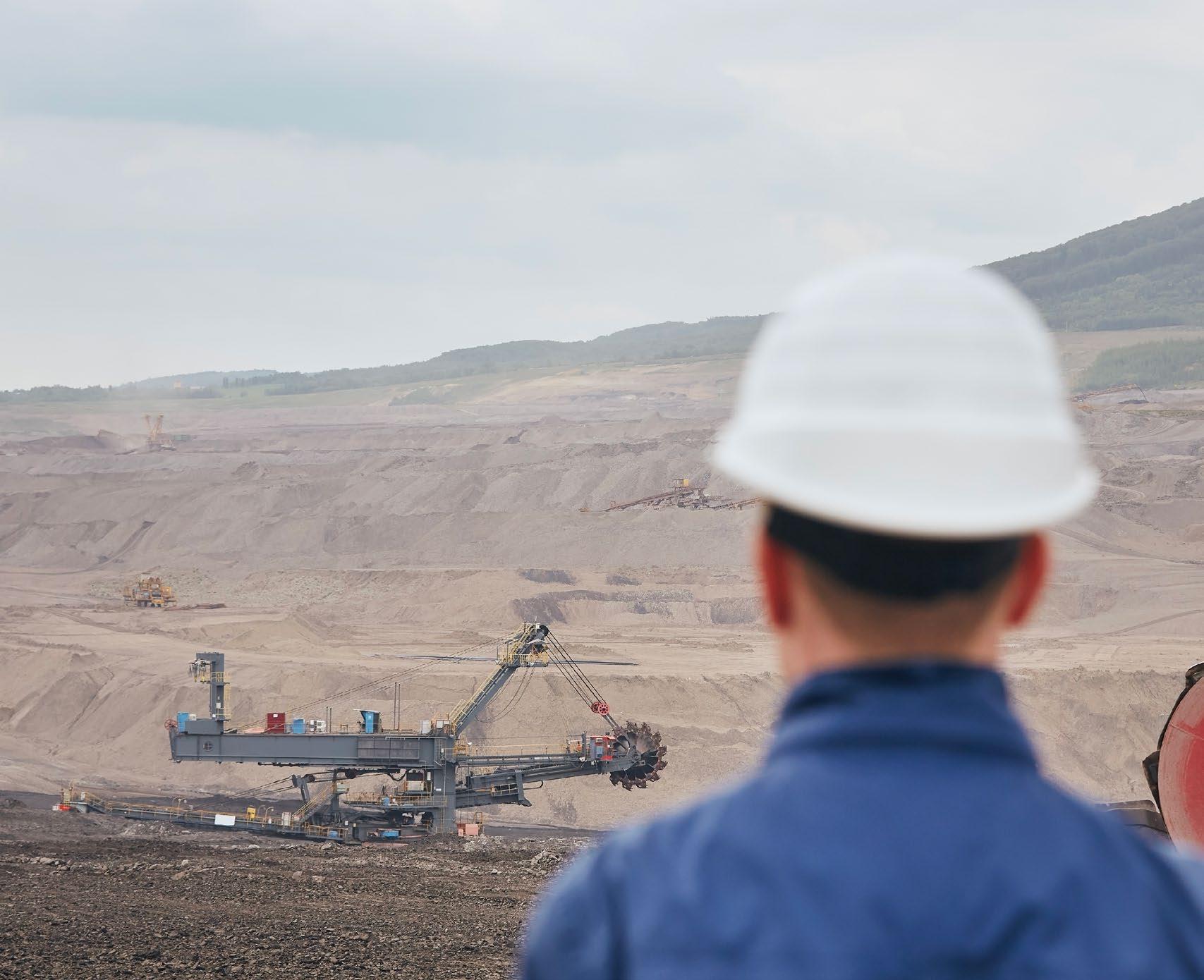
societal and technological advancement. The recovery of resources like coal, iron, copper, aggregates, and precious metals has changed the world and produced countless essential products, starting with early surface mining and continuing to the sophisticated deep underground operations used today throughout the globe.
From simple tools to the huge machinery used in open cast mines and deep under ground operations nowadays, technology has played a critical role in the growth of the industry.
T
his article will examine advancements in intelligent autonomous mining and how they might affect the direction of the sector in the future.
Mining with Intelligent Unmanned Systems: A Changing Sector
In the past, mining has been one of the main economic activities that has fueled
Technology is continually evolving with the sector, creating new prospects for enhancing mines' efficiency, safety, sustainability, and economic production.
36 | SKILLINGS MINING REVIEW October 2022 SPECIAL FOCUS
equipment that is advanced, autonomous, and linked has begun to take the position of human operators in mines, lowering labor costs and raising safety.
Another crucial expansion is the Internet of Things, which uses networks of sensors and actuators to collect data from linked devices and to improve monitoring and maintenance capabilities. Mining activities and industrial machinery have a smaller negative impact on the environment thanks to renewable energy.
Machine learning and AI are enhancing exploration, data collection, and preventive maintenance. A greater role for mobile 5G internet is being played, connecting every area of a mine in ways that were before challenging to do. The intelligent, automated mine of the future is made possible by the technological developments in the mining industry currently under development.
The Future of the Mining Sector: Intelligent Unmanned Mining?
Numerous miners have lost their lives in mining mishaps over the course of the industry's long history, including explosions
and cave-ins. As minerals that are deeper and more challenging to get are exploited in today's underground mining, the danger to the miners increases.
Even though technological advancement has made mining infrastructure safer for workers, there will always be a desire to reduce or eliminate labor presence in mines.
Mine collapses and other catastrophes can negatively affect the economic viability of mining operations, in addition to posing a risk to worker safety. When concerns are identified, workers must be evacuated, and mining operations must completely cease until the threat can be thoroughly analyzed.

Through automation and remote operations in remote, central areas, mining enterprises can now use less labor and boost safety and production. Big data, robotics, smart sensors, drones, 5G, artificial intelligence, the Industrial Internet of Things, and robots are just a few citations of the contemporary technology employed in intelligent under ground mining.
It is conceivable to transition mining from the labor-intensive operations of the past
Modern Technological Advances in the Mining Sector

So as to keep up with the needs of a changing world, the mining industry is currently undergoing a paradigm change in technical innovation. The need for the industry to address environmental, economic, and social concerns has been acknowledged by various sector actors, including businesses, governmental organizations, and researchers. In recent years, a number of transformational technologies have been created.
Equipment and procedures are becoming more automated, which improves safety, lowers costs, and streamlines operations. Workers at distant operation centers can access strong tool sets and are kept out of potentially dangerous circumstances. Robotic
www.skillings.net | 37
to the intelligent autonomous mine of the future by utilizing all available technologies at once. The foundation of the discipline is laid by the concepts of automation, mechaniza tion, visualization, and systematization. To improve and streamline operations, operators produce and use large amounts of historical and real-time data.
Reviewing the State-of-the-Art in Intelligent Unmanned Mining
The significance of this mining field study and the challenges that scientists and engineers are currently experiencing have been acknowledged in a review that has been published in the journal named "Energies" (https://www.mdpi.com/19961073/15/2/513). The work was written in collaboration with prominent scientists and researchers from the North China Institute of Science and Technology, the China University of Mining and Technology, the China Coal Research Institute, and Hohai University.
Sixty-four research publications were exam ined for the new paper, which offers various insights into recent developments in this field of study. Key technologies, mining methods, and general design system theories have all been explored in the study.
The report has outlined three major obstacles that must be solved for intelligent autono mous mining to be commercially feasible in the future. Low accuracy, poor coordination, and unreliable equipment are a few of the technology-related issues. Research should focus on these technical challenges because present systems only have a modest amount of intelligence.
The development of the field will be sup ported by the development of intelligent automation technologies, monitoring tech nologies, and control technologies. The field is very promising and provides the mining industry with a number of benefits as it meets modern needs and places more emphasis
Through automation and remote operations in remote, central areas, mining enterprises can now use less labor and boost safety and production. Big data, robotics, smart sensors, drones, 5G, artificial intelligence, the Industrial Internet of Things, and robots are just a few citations of the contemporary technology employed in intelligent underground mining.
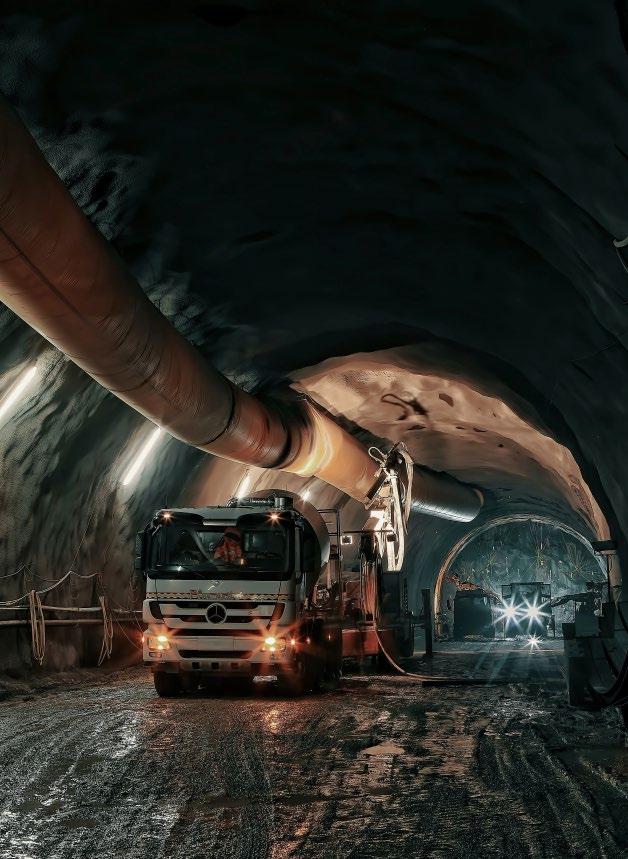
on sustainability, environmental cleanup, worker safety, and cost-effectiveness.
Future Developments in Intelligent Unmanned Mining
The topic of intelligent unmanned mining
is one that is both creative and intriguing. Technological innovation benefits the mining sector in a number of critical ways that are crucial to its continued development and use. Even if there are challenges to overcome, research has produced cutting-edge solutions for the intelligent autonomous mine.
38 | SKILLINGS MINING REVIEW October 2022 SPECIAL FOCUS
Iron & Steel: The Route Starts!
The commercial finding of the country's (Ghana) greatest iron ore deposits to date in the Oti Region and the current start of Mineral Resource Estimation (MRE) by ten local and international investors are exciting developments.
Over 6 billion tonnes of iron ore are thought to have been discovered, notably in the Akpafu Range deposits in the Oti Region, along with the Sheini Hills in the Northern Region and other occurrences elsewhere.

The introduction to the locals, traditional leaders, and political leadership in the Oti Region, investors who are beginning on their allotted blocks, serves as evidence that the vastness of iron ore occurrence is no longer a theoretical subject confined to the pages of geography books but rather a reality.
Iron and steel have played a crucial role in industrialization. We commend Presi dent Akufo-Addo for launching the Ghana Integrated Iron and Steel Development Cor poration because of this (GIISDEC).
The establishment of GIISDEC, which has specific terms of reference, distinguishes President Akufo Addo's administration from earlier ones that had no interest in the depos its. The nation came very close to taking action about the Sheini Hills deposits during the Nkrumah period, but the attempts quickly vanished into thin air. Without comets visible on the horizon today, a significant step has been made with the investment of US$10 million into the resource estimation of the natural endowments.
We must applaud the chairman of GIISDEC, the board, management, and employees for what they have accomplished in a short amount of time since the corporation's found ing since it is the first step to be made toward the extraction of the resource.
There is little question that Ghana will soon join the league of iron and steel man ufacturers.
As the extraction and processing of iron ore begin, we are eager for the technology transfer that will be available to our young graduates from numerous technical institutes across the nation. Ghana's industrialization heyday is just around the corner. It is fitting that the GIISEC board, with the chairman at the helm, started a community engagement initiative before the technical teams of the investors who have already received block allocations set up camp.
Engagement with the community in min eral extraction issues is a crucial step in establishing trust and gaining support. It is
our aim that the people of Oti Region would receive enough education about the resource happening so that they will be prepared with the essential knowledge to fend off troublemakers who may try to distance them from GIISDEC or investors.
The highest amount of iron ore in the nation is a blessing for the people who live in the Oti Region. We kindly request that GIISDEC's board and management uphold transparency in their interactions with the public and step up their CSR initiatives during peak business hours.
Allow the company to follow the best prac tices for environmental protection in all of its operations.
Alhaji Farouk Aliu Mahama, Board Chairman of GIISDEC addressing stakeholders at the workshop
Awards Ceremony Recognition:
Longwall Automation from Anglo American’s Milestones
Anglo AMEricAn hAs rEAchEd A significAnt MilEstonE in longwAll opErAtion: 100% MAchinE automation. This was made possible by its innovation-led approach to sustainable mining, FutureSmart MiningTM, and a willingness to work with industry parties.

T he METS Ignited Collaboration Award was given to the team for this work recently at the Queensland Mining Awards. The capability to remove people from dangerous situations at the face and relocate them to a specially built Remote Operations
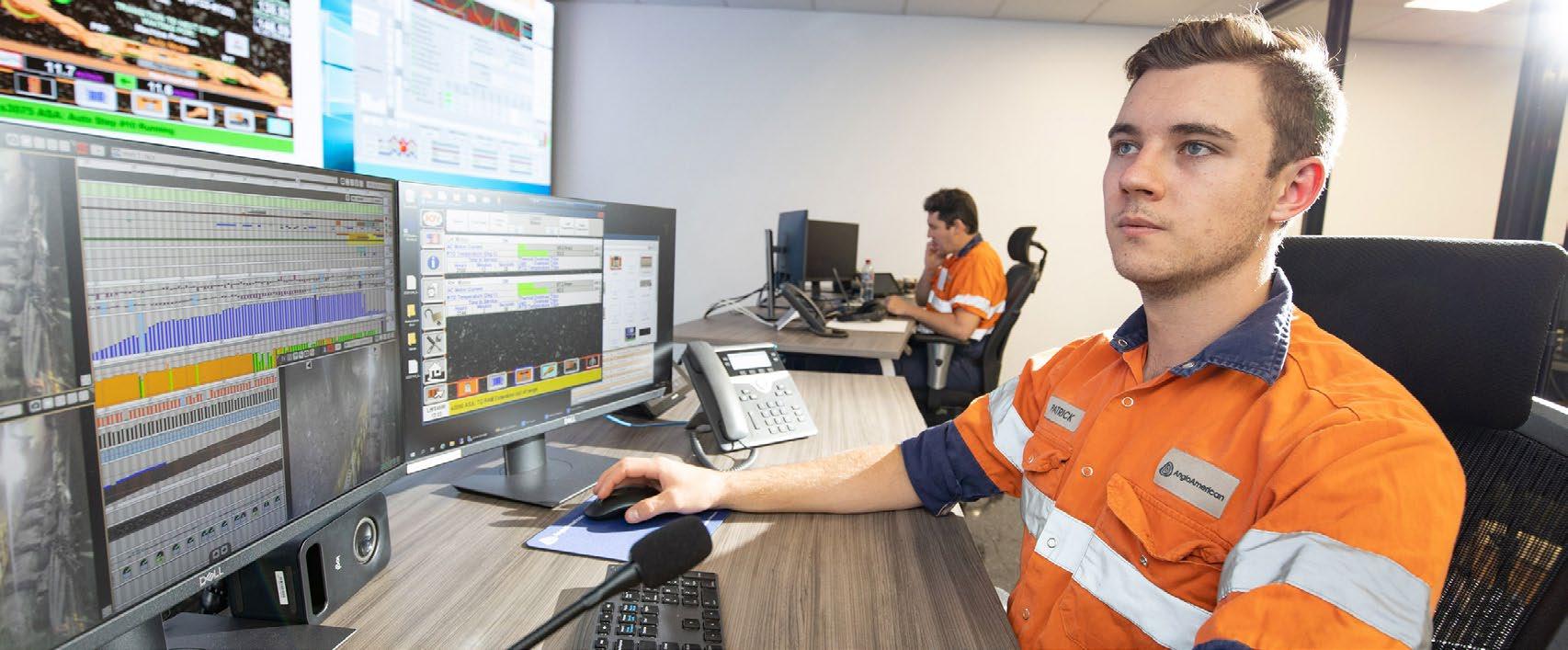
Centre (ROC) has enabled the company to deliver a breakthrough in performance that is being recognized throughout the underground coal mining industry. This capability is billed as delivering a significant step change in the safety and efficiency of
underground mining. Anglo American claims that by collaborating with partners including Restech, Aurecon, Komatsu, Eickhoff, Marco, and GTick Technologies, it was possible to build industry-first systems and technology for this project.
SPECIAL FOCUS 40 | SKILLINGS MINING REVIEW October 2022
Late in 2018, the miner, using Komatsu Mining longwall equipment, accomplished its first longwall shear totally controlled from the surface at its Grosvenor mine in Queensland, Australia.
However, out of the company's three active longwalls, the Moranbah North mine was the first to reach the 100% automation mark. A team of operational and engineering exper tise oversees the longwall mining process at this mine, which uses Eickhoff SL 900 shearers.
According to the firm, these operators, who are based above ground in the ROC, can analyze the data to lead to safer operations, better judgments, and mining excellence.
Dan Reynolds, the head of transformation for Anglo American's Steelmaking Coal business
in Australia, claimed that Grosvenor and the just-opened Aquila mines were closely behind Moranbah North as Australia's most capable remotely-operated underground steelmaking coal mine.
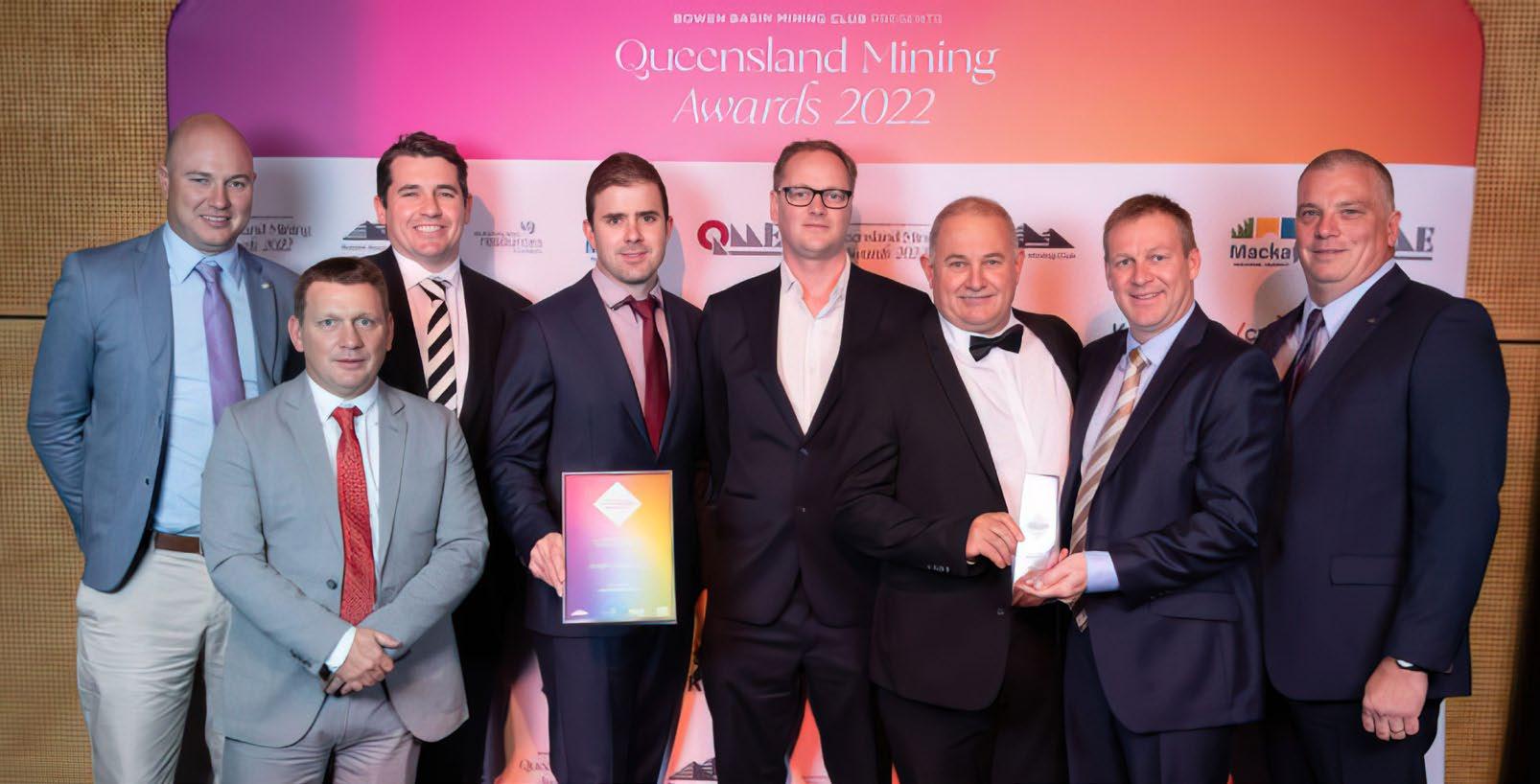
All three subterranean mines can now be operated entirely remotely from cutting-edge ROCs on the mine's surface, he claimed.
Change of pace
The primary motivations for automating longwall operations were to increase safety by lowering employee exposure to underground risks, decrease operational variability to deliver more stable operations and increase efficiency, and increase the sustainability of operations by ensuring automation resilience in a variety of operating environments.
When Anglo American was considering this move, much of the technology needed to make these improvements did not yet exist.
Additionally, Anglo American claimed that previous industry attempts to achieve sus tainable autonomous and remote operations had failed because enablers were not defined to the level required, critical operational sys tems were unavailable, OEM operating logic did not provide the necessary operational solutions, and the technology enablers were not readily available.
Anglo American recognized the need for considerable technological advancements, including the creation of numerous auto mation-enabling applications, and saw collaboration as a critical instrument for resolving these problems.
Anglo American says its Steelmaking Coal business has delivered a breakthrough performance in the development and implementation of autonomous longwall technology and remote operations for the underground coal mining industry.
www.skillings.net | 41
According to Reynolds, "after considerable workforce collaboration, the Underground Technology and Automation team built a leading practice target operating model for integrated remote operations and automation and technology enablers."
Early in the project, it was eastablished that a step shift in the availability of systems and technology would be needed to meet project objectives. The solutions that fulfilled our mining criteria were delivered by working with the OEM and third-party technology providers, who ensured the technology and software systems provided them.
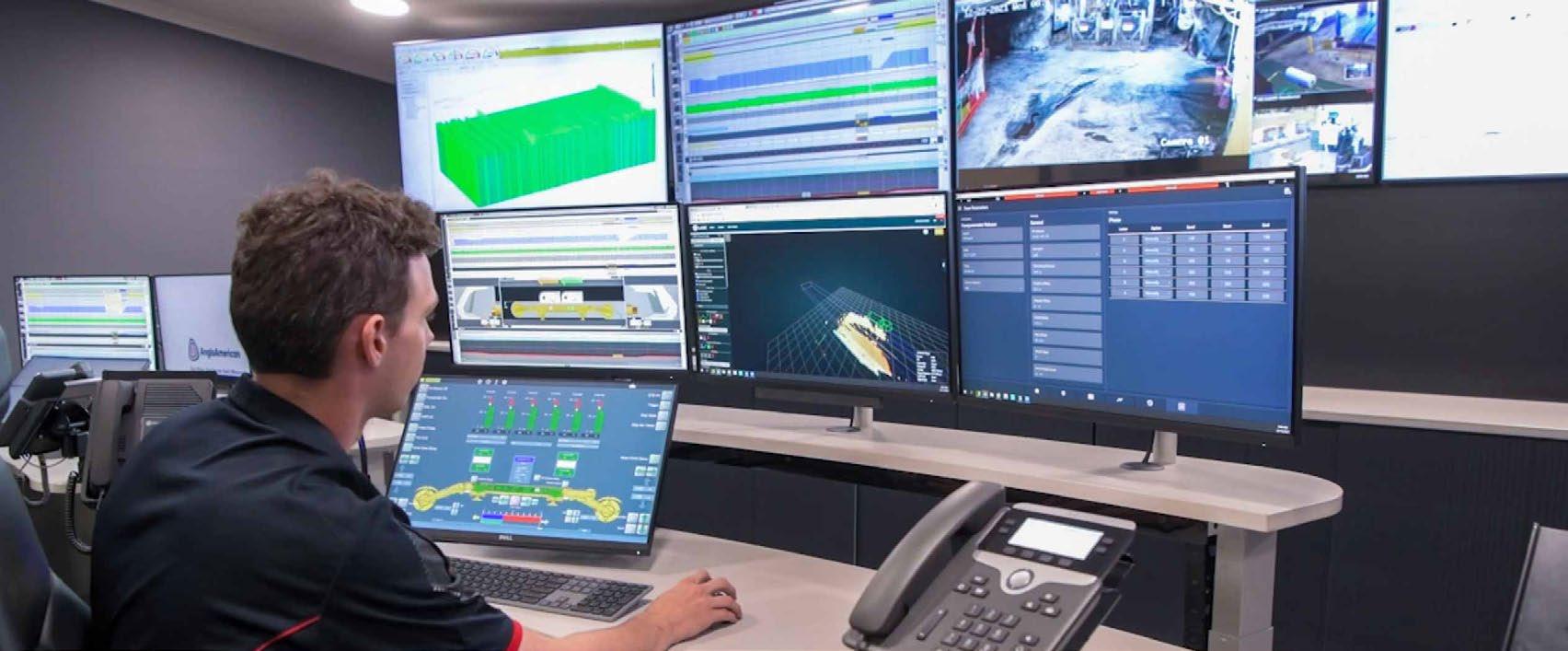
According to the business, this work required the team to collaborate with its corporate partners and underground operations to establish a number of industry-first safety and production technologies that were nec essary to "unlock" autonomous longwall operations.
As per Anglo American, the development of these technologies was made possible by the extensive cooperation between internal teams and outside providers.
The results of this experiment are substan tial, according to Reynolds. It is bringing about a considerable improvement in the stability, safety, and sustainability of under ground mining.
In its Queensland Mining Awards sub mission, the business provided more information about these technologies, many of which were spoken by suppliers and mining companies, as being the final parts
BELOW MENTIONED ARE ONLY A FEW OF THE GROUND-BREAKING, MAR KET-LEADING TECHNOLOGIES AND PROCESSES THAT THE PARTNERS HAVE CREATED:
• A longwall remote operations framework
• Autonomous shearer:
• Auto duck – system solution
• Auto gate road entry – system solution
• Anglo Seam Steering – system/ technology solution
• Integrated remote-powered roof support (PRS) control:
• Integrated face controller – sys tem/technology solution
• Remote strata control – system solution
• Enhanced logic solutions – sys tem solutions
• A Remote Operating Centre longwall system manager:
• Integrated central interface solution for longwall remote management comprising:
• Auto gate road entry
• Anglo Seam Steering

• Auto alerts
• ROC reporting
• Auto blockage detection
• Longwall positional control
• Creep management.
in the completely autonomous longwall mining puzzle.
"Auto gate road entry" refers to the longwall shearer becoming more "intelligent," using existing data from scanned files, PRS height data, or manual measurements to determine the next cut height for the gate road. "Auto duck" enables the shearer to automatically cut under roof supports in difficult strata conditions.
By automatically determining the position of the tonstein band, "seam steering" determines whether the longwall is in or out of the coal seam. Anglo American claims that this is an essential stratigraphic measurement.
Eight cameras are placed across the long wall face to perform "blockage detection," which detects if a face blockage is present and automatically alerts a ROC operator as needed.
Similarly, "longwall alerting" notifies ROC operators of probable occurrences or prob lems. "Strata management logic" makes it possible to automate shields, while "tail gate lag control" automatically determines whether the tailgate drive is lagging the face line.
According to the corporation, its Steelmaking Coal division has achieved ground-breaking success in the creation and application of autonomous longwall technology as well as remote operations for the underground coal mining sector.
SPECIAL FOCUS
42 | SKILLINGS MINING REVIEW October 2022


Name Company ............................................................................................. Address ............................................................................................... .........................................................Suite... City:..............................State:..........................Zip:.............................. Phone Fax E-Mail MINING INFO YOU DON’T HAVE TO DIG FOR... SKILLINGS MINING REVIEW. P.O. 1203 NOKOMIS, FLORIDA 34274 Subscription Information TEL: 888-444-7854 X 4 | FX: 888 261 6014 subscriptions@skillings.net SUBSCRIBE NOW FOR IRON ORE MINING NEWS AND MORE... Check your choice of Subscription Skillings Mining Review Print Subscriptions United Stages Mainland a Print Monthly Magazine Skillings Mining Review - Mail Delivered a Digital Subscription One-Month c $72 12 Months c $800 Skillings Mining Review Print Subscriptions Global a Print Monthly Magazine Skillings Mining ReviewMail Delivered a Digital Subscription One-Month c $250 12 Months c $2950 Skillings NewsRoom Digital Subscription a 3x Weekly Digital Newsletters: The Americas, Global and Equipment a Video News Updates a Digital Monthly Magazine Skillings Mining Review e-mailed a Website Full Access Skillings.net Podcast | Videos One-Month c $4.95 12 Months c $55.00 12 Months c $660.95* *Group License (Unlimited Access Company wide) c Amount Enclosed .......................................................................... c Please Bill Me Card Number: Exp. Date: c Visa c Master Card c American Express CVS No. (Security Code): ..........
MINING
Phase III RC Drilling Results Confirm Southern Extension of Christmas Gift Prospect Burracoppin Gold Project, WA
Phase III RC exploration drilling campaign completed at the Burracoppin Gold Project located along strike of Ramelius Resources “Edna May Gold Mine” in the eastern Wheatbelt of Western Australia
Highlights:
• Potential large gold endowment at the Burracoppin Gold Project based on the drill results received from the RC drilling campaigns completed by Askari Metals
• broad zones of gold mineralisation defined confirming the southern extension of the Christmas Gift prospect
• closes the gap between the mineralisation at the Christmas Gift prospect in the north and the Benbur prospect in the south – potential to join the mineralisation significantly increas es the scale of the potential gold endowment
• A total of 40 RC holes were drilled for 3,639m completed during June 2022
• Assay results from the first 9 holes have been received around the Christmas Gift prospect with results confirming the southern extension of the mineralisation at Christmas Gift
Askari Metals Limited (ASX: AS2) (‘Askari Metals” or “Company”), an Australianbased exploration company with a portfolio of battery metals (Li + Cu) and precious metals (Au + Ag) projects across Western Australia, Northern Territory and New South Wales, is pleased to announce that the Company has received the results for the first nine (9) holes out of a total of forty (40) holes drilled as part of the Phase III RC drilling program completed on its 100% owned Burracoppin Gold Project, located in the Wheatbelt region of Western Australia along strike of the Ramelius Resources “Edna May Gold Mine” (JORC (2012) Mineral Resource of 3IMt @ 1.0 g/t Au for 990,000 ounces of gold – refer to February 2022 resource update).
In June 2022, the Company completed a third phase of drilling on the Burracoppin Gold project, comprised of forty (40) RC drill holes for 3,639m. The program tested several targets, including strike extensions of the mineralisation at Burgess Find, Christmas Gift, Lone Tree and Easter Gift. The program also tested previously unexplored targets identified by the soil geochemical anomalies.
COMMENTING ON THE RESULTS FROM THE FIRST NINE (9) HOLES, VICE PRESIDENT –EXPLORATION AND GEOLOGY, MR JOHAN LAMBRECHTS, COMMENTED:
“The Company is pleased with the results of the first nine holes from the 3 phase of RC drilling on the Burracoppin project. The assay results have confirmed a southern
strike extension of the mineralisation from the Christmas Gift prospect toward the main zone of mineralisation at Benbur. Connecting these two zones with in-fill drilling will add significant scale to the future potential of the Burracoppin Gold Project.
Most of the assay results remain outstanding and the Company is eager to receive and analyse them. Once received the Company will compile them with the results from pre vious phases of drilling and will update the 3D geological model for potential resource definition.
We look forward to keeping our investors informed of the progress.”
Phase Three RC Drilling Program
The phase three RC drilling program at the Burracoppin Gold Project was designed as an extensional drilling program targeting interpreted strike extensions of the mineralisation previously identified at Burgess Find, Christmas Gift and Benbur in the North, and Easter Gift and Lone Tree in the South.
The program also tested several targets iden tified by the Company’s previously completed soil geochemical program. This program highlighted potential gold mineralisation in the far northern portion of the Burracoppin project and to the east of Benbur.
These geochemical anomalies represent highly valuable targets as they had never been tested by drilling before and may result in a significant increase in the project’s future potential if they return positive results. The phase three project did not test below and near existing areas of mineralisation. This is planned for future phases of drilling.
Holes ABRCO33-ABRCO36 were drilled to the north of Burgess Find and aimed to test the potential strike extension of mineralisa tion in this area. ABRCO33 intersected 2m @ 1.09 g/t Au from 31m downhole including
44 | SKILLINGS MINING REVIEW October 2022 UNDERGROUND
1m @ 2.11 g/t Au from 32m. This intersection was made on the eastern side of the mag netic anomaly striking through the area and did not align with the current mineralised intersections in the database and therefore warrants further investigation.
ABRCO34 intersected 3m @ 0.75 g/t Au from 99m downhole including Im @ 1.17 g/t Au from 99m. This intercept aligns with the current interpreted mineralisation model and represents a deep intersection. Hole ABRCO35 did not intersect any significant gold mineralisation. Hole ABRCO36 was
drilled to the northwest of the Burgess Find prospect and failed to intersect any significant mineralisation in this area. Interpretation of the current results indicates that minerali sation may lie westward of its design. This will be revisited once all the results have been received.
Hole ABRCO37 was designed to test for a separately interpreted set of the mineralised units parallel and to the west of the primary mineralised system on the Burracoppin Gold Project. Hole ABRCO37 was abandoned at 9m depth and redrilled a few meters away
as ABRCO37A. Both holes intersected miner alisation near the surface, with hole ABRCO37 intersecting 4m @ 1.76 g/t from the surface, including 3m @ 2.11 g/t Au from the surface. Hole ABRCO37A intersected 4m @ 0.97 g/t Au from surface including 1m @ 1.31 g.t Au from surface.
ADVERTISING INDEX
Azcon

45
ABT................................................ 21
Barr Engineering
CR Meyer
FloLevel Technologies
We thrive on challenges
golder.com
15
23
25
Fryberger....................................... 15
General Equipment Supplies
05
Global Minerals Engineering........ 45

Golder Associates
Halcor
Lake Superior Chapter ISEE
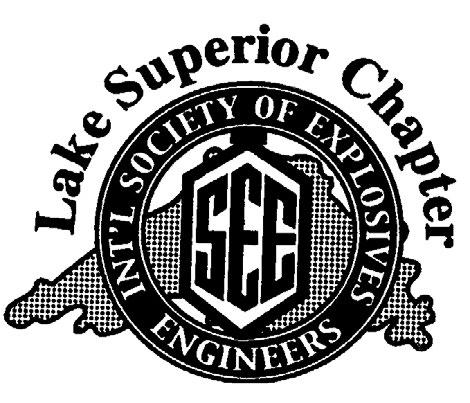
Malton Electric Company

ME Elecmetal
Minnesota Power
Mielke Electric Works
Naylor Pipe
Neo Solutions
Northern Engine & Supply

Optiro
SEH
45
13
45
45
07
17
17
48
19
45
02
21
...........................................
...........................
......................................
.................
.......
........................
...........................................
.........
............
...............................
.........................
..................
...................................
...............................
............
............................................
...............................................
www.skillings.net | 45
august 2022 crude steel production

Worldcrude steel production for the 64 countries reporting to the World Steel Association (worldsteel) was 150.6 million tonnes (Mt) in August 2022, a 3.0% decrease compared to August 2021.
CRUDE STEEL PRODUCTION BY REGION
Africa produced 1.3 Mt in August 2022, up 3.5% on August 2022. Asia and Oceania produced 112.6 Mt, down 0.2%. The EU (27) produced 9.7 Mt, down 13.3%. Europe, Other produced 3.6 Mt, down 18.6%. The Middle East produced 3.2 Mt, up 34.2%. North America produced 9.6 Mt, down 5.4%. Russia & other CIS + Ukraine produced 6.9 Mt, down 22.4%. South America produced 3.6 Mt, down 10.1%. The 64 countries included in this table accounted for approximately 98% of total world crude steel production in 2021. Regions covered by the table: Africa, Asia and Oceania, European Union (27), Europe, Middle East, North America, Russia & other CIS + Ukraine, South America.
Table 1. Crude steel production by region
TOP 10 STEEL-PRODUCING COUNTRIES
China produced 83.9 Mt in August 2022, up 0.5% on August 2021. India produced 10.2 Mt, up 1.2%. Japan produced 7.3 Mt, down 7.4%. The United States produced 7.0 Mt, down 7.1%. Russia is estimated to have
produced 5.9 Mt, down 5.5%. South Korea is estimated to have produced 6.1 Mt, down 0.4%. Germany produced 2.9 Mt, down 2.3%. Türkiye produced 2.8 Mt, down 21.0%. Brazil produced 2.8 Mt, down 11.3%. Iran produced 2.1 Mt, up 64.7%.
Table 2. Top 10 steel-producing countries
aug 2022 (mt) % change aug 22/21 jan-aug 2021 (mt) % change jan-aug 22/22
africa 1.3 3.5 9.7 -7.4 asia and oceania 112.6 -0.2 925.1 -4.3 eu (27) 9.7 -13.3 95.3 -6.9 europe, other 3.6 -18.6 31.0 -8.4
middle east 3.2 34.2 28.5 6.9
north america 9.6 -5.4 76.0 -3.6 russia & cis + ukraine 6.9 -22.4 59.1 -18.2 south america 3.6 -10.1 29.2 -4.1 total 64 countries 150.6 -3.0 1,253.9 -5.1
aug 2022 (mt)
% change aug 22/21 jan-aug 22 (mt)
% change jan-aug 22/21
STATISTICS china 83.9 0.5 693.2 -5.7 india 10.2 1.2 83.5 7.1 japan 7.3 -7.4 60.7 -5.2 united states 7.0 -7.1 54.9 -3.7 russia e 5.9 -5.5 48.9 -5.8 south korea e 6.1 -0.4 46.0 -3.0 germany 2.9 -2.3 25.4 -4.8 turkey 2.8 -21.0 24.4 -8.8 brazil 2.8 -11.3 23.1 -4.5 iran 2.1 64.7 19.5 7.8
The 64 countries included in this table accounted for approximately 98% of total world crude steel production in 2020. Regions and countries covered by the table: Africa: Egypt, Libya, South Africa. Asia and Oceania: Australia, China, India, Japan, New Zealand, Pakistan, South Korea, Taiwan (China), Vietnam. CIS: Belarus, Kazakhstan, Moldova, Russia, Ukraine, Uzbekistan. European Union (27). Europe, Other: Bosnia-Herzegovina, Macedonia, Norway, Serbia, Turkey, United Kingdom. Middle East: Iran, Qatar, Saudi Arabia, United Arab Emirates. North America: Canada, Cuba, El Salvador, Guatemala, Mexico, United States. South America: Argentina, Brazil, Chile, Colombia, Ecuador, Paraguay, Peru, Uruguay, Venezuela
46 | SKILLINGS MINING REVIEW October 2022
COUNTRY
CHANGE DEC-20/19
% CHANGE
Austria 530 e 521 1.7 6 665 -10.2
Belgium 359 505 -28.9 6 119 -21.1
Bulgaria 40 e 43 -6.3 485 -14.3
Croatia 15 e 7 101.9 47 -32.0
Czech Republic 408 359 13.7 4 465 0.6
Finland 339 186 81.8 3 500 0.8
France 1 155 918 25.7 11 596 -19.8
Germany 3 137 2 835 10.6 35 658 -10.0
Greece 110 e 94 17.0 1 430 5.9
Hungary 90 164 -44.8 1 513 -14.5
Italy 1 500 e 1 404 6.9 20 200 -12.9
Luxembourg 113 97 17.3 1 886 -11.0
Netherlands 540 521 3.6 6 054 -9.1
Poland 680 e 642 5.9 7 890 -11.9
Slovenia 50 e 34 45.0 570 -8.5
Spain 891 765 16.4 10 934 -19.5
Sweden 410 376 8.9 4 409 -6.6
United Kingdom 710 e 550 29.0 7 185 -0.5
Other E.U. (28) (e) 680 e 642 6.0 8 180 -12.1
European Union (28) 11 757 10 665 10.2 138 786 -11.8
Bosnia-Herzegovina 75 70 6.5 759 -5.2
Macedonia 33 24 35.9 180 -24.8
Norway 41 40 3.2 624 0.5
Serbia 119 158 -24.8 1 456 -24.6
Turkey 3 403 2 893 17.7 35 763 6.0
Other Europe 3 671 3 185 15.3 38 782 3.9
Byelorussia 200 e 225 -11.2 2 490 -5.0
Kazakhstan 355 e 374 -5.0 3 835 -7.2
Moldova 45 e 35 28.2 465 18.7
Russia 6 110 e 6 159 -0.8
Ukraine
2.6
COUNTRY
Mexico
Canada
Cuba
Guatemala
%CHANGE DEC-20/19 2020 % CHANGE
1 550 e 1 361 13.9 16 854 -8.3
United States 6 434 7 292 -11.8 72 690 -17.2
North America 9 107 9 801 -7.1 101 119 -15.5
Argentina 388 326 19.0 3 651 -21.4
Brazil 2 886 2 462 17.2 30 971 -4.9
Chile 105 e 109 -3.5 1 165 2.8
Colombia 110 e 97 13.5 1 126 -15.5
Ecuador 50 e 50 0.5 477 -21.5
Paraguay 3 e 3 -4.4 22 -17.5
Peru 105 e 91 15.8 671 -45.4
Uruguay 5 e 5 -7.2 47 -24.6
Venezuela 2 e 0 315.8 29 -43.6
South America 3 654 3 143 16.3 38 158 -8.4
Egypt 994 574 73.0 8 229 13.4
Libya 73 63 16.2 495 -18.4
South Africa 292 e 297 -1.5 3 877 -37.0
Africa 1 359 934 45.5 12 600 -10.1 Iran 2 660 e 2 224 19.6 29 030 13.4
Qatar 85 186 -54.3 1 218 -52.4 Saudi Arabia 440 664 -33.8 7 775 -5.1
United Arab Emirates 280 297 -5.8 2 722 -18.2
Middle East 3 465 3 371 2.8 40 745 2.7 China 91 252 84 692 7.7 1 052 999 5.2
India 9 796 9 383 4.4 99 570 -10.6
Japan 7 526 7 785 -3.3 83 194 -16.2 South Korea 5 952 5 880 1.2 67 121 -6.0
Pakistan 380 e 261 45.6 3 743 13.3 Taiwan, China 1 700 e 1 693 0.4 20 570 -6.3
Thailand 410 e 357 14.8 4 420 4.1
Vietnam 1 600 e 1 876 … 19 500 11.6
Asia 118 616 111927 6.0 1 351 117 1.6
Australia 473 449 5.4 5 490 0.0
New Zealand 59 57 3.8 586 -12.2 Oceania 533 506 5.2 6 076 -1.4
Total
969 5.8 1 829 140 -0.9
DEC 2020 DEC 2019 %
2020
73 400
1 906 1 561 22.1 20 616 -1.1 Uzbekistan 80 e 84 -4.8 950 42.6 C.I.S. (6) 8 696 8 438 3.1 101 756 1.5
1 070 e 1 092 -2.0 11 078 -14.1
20 e 22 -8.5 181 -21.4 El Salvador 8 e 8 -5.7 79 -22.5
25 e 26 -3.9 237 -22.6
DEC 2020 DEC 2019
64 countries (1) 160 858 151
(1) - HADEED only. (2) - the 64 countries included in this table accounted for approximately 99% of total world crude steel production in 2019. e - estimated CRUDE STEEL PRODUCTION DECEMBER 2020. Source – World Steel Association www.skillings.net | 47

